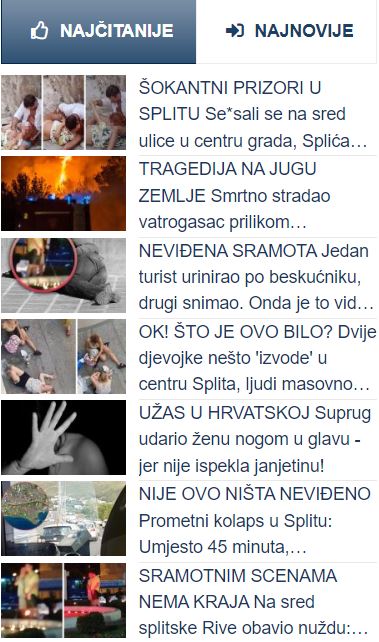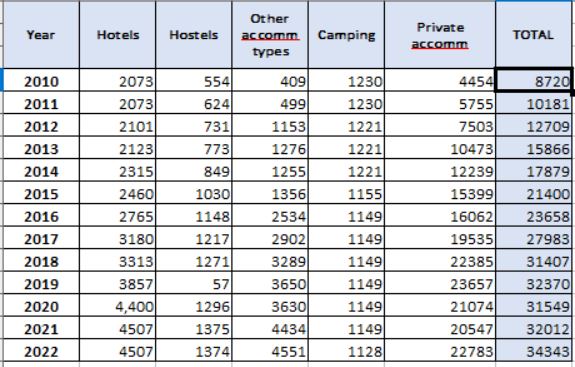Stage Set for 35th LEN European Water Polo Championships in Split!
August 26, 2022 - The 35th LEN European Water Polo Championships will be held in Split at the Spaladium Arena from August 27 to September 10, 2022.
Head of the organizers, Renato Zivkovic, said at the opening press conference on Friday morning that since Split had earned the right to host the event in 2018, they had to overcome the impacts of the pandemic and now the ongoing war – but with the support of the Government, the city and their partners, they were able to deliver everything they had planned.
“Despite all these difficulties, we remained calm and solved the problems in the best possible way over the last six months, though this was very demanding. But now what matters is that we have 28 teams here, 92 matches to play in 15 days – two pools were constructed, the arena is decorated, and
everything is ready for the great show. I hope that everyone will enjoy the next two weeks.”
“I’ve been here for many events, handball championships, concerts, but for me, the Arena looks the most beautiful now, and it would be nice if the pool could stay forever,” said Milos Mracevic, speaking on behalf of LEN as Bureau Member and water polo liaison.
“We can’t wait for the start of the competition and pass the floor to the main stars of the event. On behalf of LEN President Antonio Silva and First
Vice-President Josip Varvodic, we are all grateful to the Croatian Water Polo Federation for what they have done in the last year and the enormous efforts they’ve put in to have a successful event in Split. I’m sure that in the end, everyone will leave with the most positive impressions.”
LEN Operational Manager Marco Birri highlighted that 34 broadcasters would have live coverage of the championships, and LEN also offers a free live stream of each game with on-site commentary.
“On our new platform, which is available through our website, we’ll feature even more content, while you may relive each and every goal scored in Split by visiting our livescoring site, where the goal clips will be featured almost immediately as the game progresses.”
The championships begin with the first two rounds of the women’s tournament on Saturday and Sunday, while the men’s tournament starts on Monday.
Ivica Tucak, coach of the Croatia men’s team, spoke at the press conference as well:
“We had the privilege to play a practice game with Serbia in this beautiful venue – congratulations to Renato and the entire organizing team who worked on this wonderful project. I’m sure we’ll have a fantastic championship here in Split. As for the team, everybody will give his absolute top to represent the country in the best possible way. We have ambitions, but we have a completely new team compared to Tokyo. Going through all the changes and forming a new team is never easy, and we also had to deal with injuries and sickness, so we’ll miss a couple of players. Still, we proved our strength at the World Championships and the warm-up tournaments, we have a lot to offer, and we have the same goal as always – that is, reaching the semis and playing in the medal round. It’s difficult to predict anything, but we are ready to play in this beautiful city, in front of our fans, show our best and go as far as we can.”
To follow the latest sports news in Croatia, follow TCN's dedicated page.
Hajduk Drops Out of UEFA Europa Conference League After Play-off Defeat to Villarreal
August 25, 2022 - Hajduk has dropped out of the UEFA Europa Conference League on a 2-6 aggregate to Villarreal. The Split club lost 0:2 at Poljud on Thursday night.
Hajduk and Villarreal met in the second leg of the Conference League play-off at a sold-out Poljud stadium on Thursday. In the first match, Villarreal won 4:2 in Valencia, meaning Hajduk needed to score three goals to have a chance.
Villarreal is one of the best European teams and was certainly the favorite to move ahead. The Spanish club is last year's Champions League semi-finalist, and Europa League champions the season before that, knocking out Dinamo Zagreb on their way to the title.
Hajduk had met Spanish clubs five times so far in European competitions but failed to move past them.
"It will be a difficult test because Villarreal likes to control the game and have possession of the ball. We have to be patient and focused for the whole 90 minutes and pay attention to small details," Hajduk coach Valdas Dambrauskas said before the match.
"In that beautiful stadium, we expect a good atmosphere in which we will try to manage the match," said Villarreal coach Unai Emery.
Lineups
HAJDUK: Kalinić - Mikanović, Awaziem, Elez, Melnjak - Grgić, Fossati - Sahiti, Krovinović, Biuk - Livaja
VILLARREAL: Reina - Kiko, Mandi, Cuenca, Pedraza - Chukwueze, Parejo, Coquelin, Baena - Lo Celso, Nicolas
Match report
Villarreal had their first attack in the 2nd minute, which went out for a goal kick. Melnjak played a hospital ball to a Villarreal player at the top of the box. Kalinic luckily saved the shot, but Hajduk fouled in the next play. A free-kick awarded to Villarreal found the head of Baena, who went over the post.
It was a shaky first five minutes for Hajduk, who was playing nervously.
A quick counter which started from Awaziem found Sahiti on the right and went out for Hajduk's first corner. The ball was played out by the Villarreal defense and sent back in by Sahiti, who found Livaja's head. Marko just missed near post.
Another attack for Hajduk came in the 10th minute and Fossati managed to get a shot off which was blocked.
Another shaky instance in the Hajduk defense came a minute later and was luckily cleared by Melnjak.
Another brilliant attack by Hajduk in the 14th minute saw Livaja get a shot off which was deflected out for a corner. Krovinovic found Livaja again, whose one-touch shot went over the goal.
Sahiti dribbled through the Villarreal defense in the next play and shot at the keeper. Livaja tried lobbing the keeper from the halfway line in the 16th minute. And he hit another rocket that went just wide of the far post in the next play.
Mikanovic was shown a yellow card in the 19th minute.
Villarreal tried a quick counter in the 22nd minute but shot straight at Kalinic. Hajduk countered back and Biuk got a shot off which was deflected to Reina.
Hajduk was hungry and had another corner in the 25th minute, followed by another after that.
Villarreal started to possess the ball and tried to move into the box. Nicolas' fancy footwork couldn't move past Hajduk's defense.
A Hajduk free kick in the 30th minute was played short to Biuk on the left. The young midfielder cut into the middle and fell for a foul, but the ref said to play on. Hajduk's next attack was called offside.
A dangerous free kick for Villarreal in the 34th minute was taken in front of the corner spot. Luckily the ball went straight to Kalinic.
But just a few minutes later, Pedraza had his chance, playing around Hajduk's defense with no one in the block. He shot far post into Kalinic's goal for 0:1 Villarreal. Hajduk's hope had dwindled.
A Livaja free kick in the 41st minute was taken from about 30 meters out and went just wide of the post. The first half ended 0:1 for Villarreal.
Villarreal made one sub to start the second half - Capoue went on for Coquelin. Hajduk did not make any changes.
A dangerous chance for Villarreal came in the 47th minute, which was blocked by the Hajduk defense. A standout save by Kalinic in the 51st minute stopped Villarreal from going ahead by two goals.
Another attack for Villarreal in the next minute went out for a corner. Hajduk managed to clear any dangerous plays and tried to calmly move the ball into Villarreal's half but could not get a shot off.
In the next attack, Chukwueze's shot slipped through Kalinic's hands and into the goal for 0:2 Villarreal. Hajduk would now need 4 goals to bring the match to extra time.
Villarreal made substitutions in the 58th minute - Moreno came on for Jackson and Morales for Lo Celso.
Hajduk made their first subs in the 59th minute - Lovrencsics came on for Mikanovic and Mlakar for Sahiti.
Fossati was subbed off for Vukovic in the 65th minute.
Mlakar had a great chance to score a minute later but just missed the far post.
Krovinovic was fouled right on the corner of the box in the 71st minute. The same player took the free kick, which went out for a goal kick.
Hajduk had a free kick and a corner in the 75th minute without a chance for a goal.
Pau Torres came on for Pedraza and Foyth for Kiko in the 79th minute. Colina came on for Melnjak and Simic for Elez in the same minute.
There were no dangerous chances for either team in the final 10 minutes. The ref added 3 minutes of stoppage time, in which no one scored.
Hajduk has thus dropped out of the UEFA Europa Conference League.
Post-match comments
Villarreal coach Unai Emery
"We played against a team that is good today but also has a rich past. The atmosphere created by the fans was special, and we enjoyed it. I'm sorry when a team like Hajduk is left out of the European competition. With this kind of atmosphere and fans, it deserves to be in the European competition. I have to repeat that in the first game, we made several mistakes, and now we managed to improve some things that we did in the first game at a lower level. This is Europe; we have to be concentrated and satisfied with this kind of game."
Hajduk coach Valdas Dambrauskas
"I can't fault the players. We were ready and better than in the first game. The difference in class between us and Villarreal is too big, especially in two games. We turn to Osijek, which for us as the final, will not be easy, but we have to focus. We showed a level we can be proud of, but we have to improve," said Dambrauskas.
"A big thank you to the fans for their support during and after the match. It's a big responsibility. I'm not afraid to say it, and I know it sounds like a cliché, but we really have the best fans in Europe. We really do. Someone compares us to Napoli and Marseille, but we are not even the first in Croatia, we do not play in the European League nor the Conference League, and we have such support. The players and we are very proud to have this kind of support."
To follow the latest sports news in Croatia, follow TCN's dedicated page.
Split during the French Administration of Napoleon Bonaparte
August 22, 2022 - TCN is delighted to welcome Marko Lončar to the team. Marko will be adding a little historical perspective, starting with a look at Split under French Administration at the turn of the 19th Century.
“Impossible is a word to be found only in the dictionary of fools.”
Napoleon Bonaparte
In the wake of the French revolution, revolutionary ideas of liberty, freedom, and equality were spreading over Europe like wildfire. Napoleon, in his war campaigns, made sure that these new values be implemented in the conquered regions and for the benefit of the people so as to set the basis of a paradigm shift that was supposed to supersede the old and outworn feudal laws and principles that shaped a bygone world. No different was the fate of the people on the east coast of the Adriatic Sea.
Even though France defeated Austria and signed the Treaty of Campo Formio in 1797, which put an end to the 1100-year existence of the Venetian republic and placed Istria and Dalmatia under Austrian rule, it was not until after the Battle of Austerlitz, followed by the Peace of Pressburg in December 1805 that these provinces came under French governance and were included in the Kingdom of Italy, an entity under Napoleon’s full control through his stepson Eugene Beauharnais who acted as a viceroy. (Kečkemet 2006) This first period of French rule lasted until 1809 and the formation of Illyrian Provinces and was marked by the governance of Vincenzo Dandolo, who was appointed general superintendent of Dalmatia. (Kečkemet 2006)
Dandolo, a scientist, chemist-pharmacist, and agriculturalist, and a subordinate to marshal August Marmont, occupied his post in the city of Zadar, then the capital of Dalmatia. He was responsible to put into action Marmont’s commands and directions - a set of ideas and visions all fashioned in the spirit of the Enlightenment. He regarded the region as underdeveloped and was set to make improvements by building roads, introducing public education system, upgrading trade and commerce, and since he was an inveterate agriculturalist, modernising primitive agricultural methods that were predominant in the region at the time. (Kečkemet 2006)
When it comes to Split, an emphasis was put on aesthetics, culture, and social life of the city. Such was the decision to tear down old shabby houses in front of the south façade of Diocletian's palace. Foundations for the new public park, colloquially known as Đardin, were set then from the rumbles of bastions that encircled the city core and were built during Venetian’s reign. The idea behind deconstructing parts of bastions was to open up the city and make it more susceptible to growth and development outside the city walls, and to include old city neighbourhoods Lučac, Manuš, and Dobri into shaping the city’s social life, but also to ease the possibility of defending the city in case of enemy threat. The decision to tear down the Venetian castle west of the palace and to use the remaining material to expand the boardwalk on the west coast came from the fear that Russian or British troops could seize it and use it as a stronghold to carry out attacks on the city. (Kečkemet 2006) Improvements in postal service were also made and went along with construction and enhancements to traffic routes. (Kečkemet 2006) Regarding social activities, tombola events were organized in the theatre, and part of the earnings went to the “Committee for public charity” that took care of hospitals, orphanages, almshouses, and mental hospitals that the French found in terrible conditions, and since charitable work, care for the general well-being of the citizens, as well as the incentive to bring about an egalitarian and more just society, was an integral part of the legacy of French revolution thus it was in the focus of French governance, most notably that of marshal Marmont. (Kečkemet 2006) Marshal Marmont felt a special appeal to Split. He was enchanted by picturesque landscapes and scenery but also by the city’s rich history, ruins of Salona, and most notably the remnants of the breath-taking palace.
Upon the arrival of the French, city streets were unkempt, filthy, and feculent, with drains of outflow and sewage waters running on its surfaces, including the one that today bears the name in honour of August Marmont. Having seen how big a problem this poses to public health care, a decision was made to pave the city streets and redirect the flow of sewage waters, an undertaking that was partly done at the expense of residents and clergy. (Kečkemet 2006) The general idea of participation and involvement of the citizenry in public projects was encouraged if not even imposed, and all with the aim of raising the level of consciousness of an individual and his role and influence on society as a whole. Along with introducing a public health-care system, Marmont made effort to embellish the city by issuing a decree to build public parks and gardens and forming a “Commission for the embellishment of Split”. The commission’s task was to take care that new houses on the coast be built in accordance with the plans and blueprints of Basilio Mazzoli.
The egalitarian approach in reshaping society brought about some notable resistance in certain classes of the society, particularly among the nobility, clergy, and commoners who were heavily influenced by the clergy. Redistribution of property that affected the clergy included property and church inventory being confiscated with the aim to help fund further warfare, but also some monasteries were used to accommodate the French army and officers. Nobility lost part of their lands and estates. Some fraternities, that counted thirty-four in Split alone at the time, were suspended from activity by the decree of viceroy Eugene, dating from 20th October 1808. “Fraternity of The Holy Sacrament” and “Fraternity of the Good Death” were left unharmed, most likely due to the reason that their work included burial of the deceased, especially of the poor. (Duplančić 2011)
Another feat worthy of mentioning was the full integration of the Jewish minority into society. Jews were condemned to ghetto life, and the decision to bring down ghetto doors as well as to proclaim religious liberty was greeted enthusiastically among the members of the Jewish community. (Kečkemet 2006) All citizens were regarded equal before the law, and implementation of a new set of principles that intrinsically belonged to Napoleon’s most significant work - Code Civil.
Though French initiatives were commonly perceived as anti-clerical, and secularism and laicism were instilled in changes imposed by them, marshal Marmont held members of the Franciscan order in high regard. He did not fail to see how influential the order was among commoners and that it would be opportune to be well-disposed to the order so as to try to swing in his favour the disapproving bearing of the public. Those who felt inclined towards revolutionary ideas of the French were predominantly members of the citizenry, especially intellectuals who were not averse to embracing new values and ideas of the Enlightenment. (Kečkemet 2006)
Since the foundation of Illyrian provinces in 1809 and Marmont’s relocation to Ljubljana to occupy the post of the general governor, activities on embellishing the city were slowed down, and many never saw the light of day, and the implementation of the revolutionary ideas slackened. Marmont was occupied leading war campaigns across Europe, being wounded twice but nevertheless participating in battles head high and baldly executing His Imperial Majesty’s will. Subsequently, due to disappointment in Napoleon and thinking that he had placed himself above France, he turned against him and parleyed to surrender Paris. (Kečkemet 2006)
French governance over Dalmatia lasted until 1813 and the battle of Leipzig, the decisive defeat of Napoleon’s army on the continent. (Britannica 1998) Though oftentimes regarded as usurping, particularly among those who were most affected by changes imposed, we can beyond doubt credit the French governance for doing so much for the benefit of the people in so little time, especially for the introduction of ground-breaking libertarian ideas.
To learn more about Split today, check out the Total Croatia Split in a Page guide.
Luxury Hospitality Expert Zoran Pejovic on Split Tourism Development
August 15, 2022 - Continuing our look at how to improve tourism in Split, one of the city's tourism pioneers, Hotel Development Specialist and Expert Tourism Consultant Zoran Pejovic of Paradox Hospitality, offers his thoughts.
TCN's recent editorial Is Split Tourism 'Strategy' Killing the Goose with the Golden Eggs? attracted quite a lot of attention, as we tried to uncover how Split - which has grown exponentially as a destination over the last decade - has been attracting a lower class of drunken tourist in recent times, whose actions have flooded the TCN inbox with requests from expats, locals, and tourism businesses to try and highlight the issues with a view to finding solutions. I am very grateful to Mayor of Split, Ivica Puljak, Split Tourist Board Director, Alijana Vuksic, and legendary tourism consultant Mario Seric, for all putting their views in the editorial which you can read in the link above.
Their thoughts were followed by a great interview with the founder of the ULTRA Europe Festival, Joe Basic, whose vision was fascinating, as were his practical solutions to improve the situation relatively quickly and painlessly. You can read his interview here.
Next up, one of the pioneers of luxury tourism in Croatia, the man who brought the wine bar to Split (did you know that they did not exist 10 years ago?), and a friend I have known for 10 years, as we have watched the direction of Split and Croatian tourism over many a glass of wine and beer. Zoran Pejovic of Paradox Hospitality is not a man who does things by halves, and the Paradox Wine and Cheese Bar, Paradigma fine dining restaurant, and Maslina Resort on Hvar are just three examples of him pushing the boundaries of quality and innovation in Dalmatia in the last decade.
1. Take us back a decade. Paint a picture of Split as a destination. What attracted you to move there?
My decision to move to Split was a concoction of many different, unrelated global and personal events. It involved, among other factors “the coming out” of the global financial crisis, me having a best friend in Split, and my thoughts on how Split obviously must be the center of tourism in the Adriatic, given its geography, history, and culture. I have been coming to Split ever since 2001, and in those early years was always amazed and flabbergasted how most of the restaurants in the city center took August as their collective annual leave. Mind you, I was living in Dubrovnik back then, which was already doing very, very well, and the summers felt like a festival of tourism while Split was firmly outside of the tourist maps. However, in the years leading up to my move to Split, I was living across the globe and was very unfamiliar with the state of the industry.
I remember asking Marko, my partner to be in our common hospitality venture, if he could write up a list of the five best restaurants for me to visit on my arrival in Split, in December of 2011. I have asked the same for the wine bars, hotels, and so on. He came back with a list of three restaurants of which two were konobas, one hotel, and zero wine bars. I then asked him to ask his colleagues, all in the top management positions in Splitska Banka to write up their lists. They came back with the same lists. I was shocked and at the same time certain that Split had to be the next Barcelona. It was a platform that just had to be upgraded with the right mix of hotels, restaurants, and wine bars, and alongside the specialized destination management companies focusing on culture, adventure, and experiential offerings it was destined to be successful on all fronts.
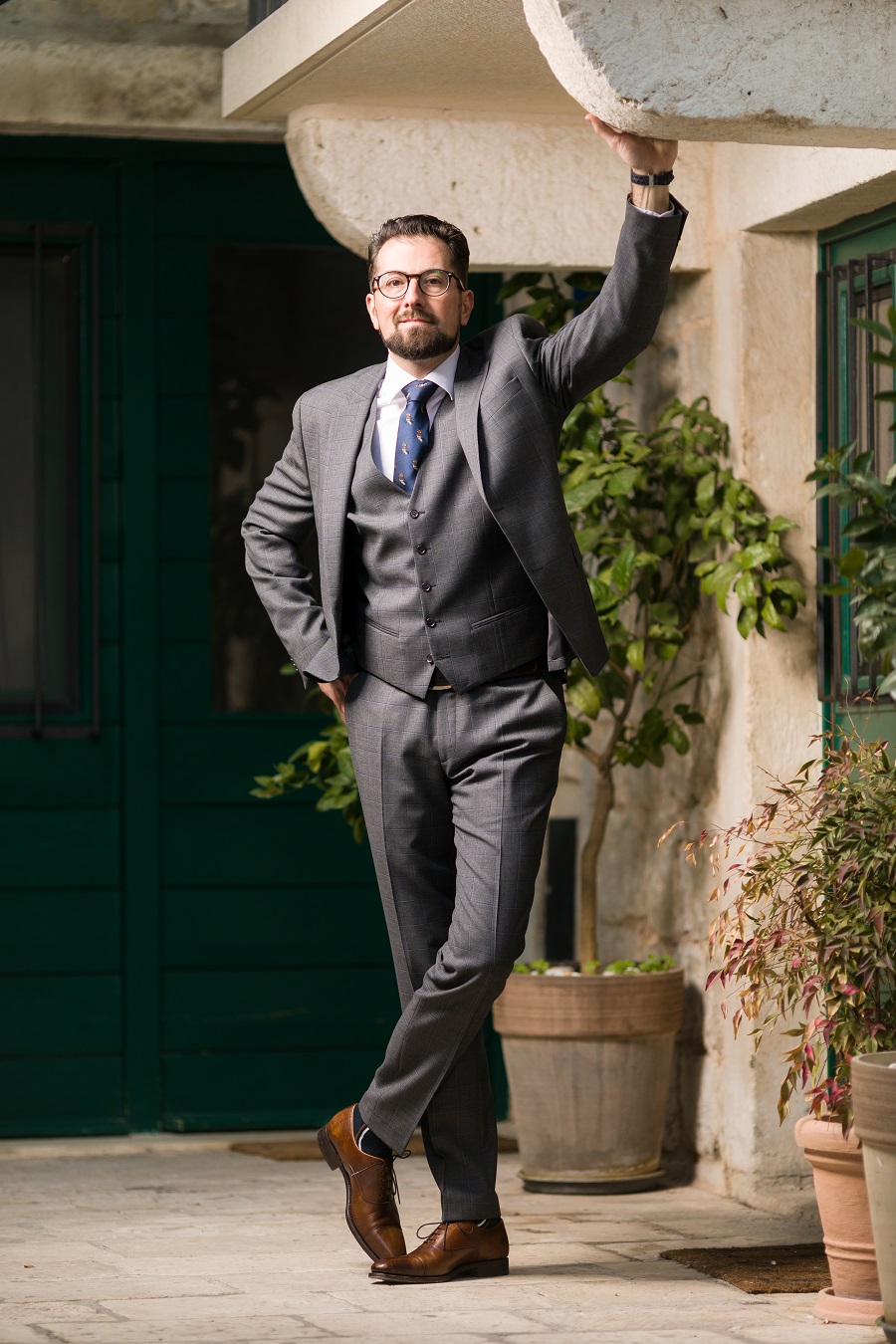
(Photo by Nikola Radovani)
2. You brought the wine bar to Split, a true pioneer. Tell us about that, and how things developed due to your initiative. Are you happy with the results?
Firstly, we could not have opened a wine bar, as such categorization did not exist within the rules and standards on classification, minimum conditions, and categorization of catering facilities. There was a pub as an option, mind you, not a wine bar. I don’t believe that has changed in the meantime. We have faced so many weird questions and constraints that we have decided to officially name our konoba, dressed as a wine bar, Konoba “Wine & Cheese Bar Paradox”. A lot has happened right off the bat. People thought that we were crazy offering 50 wines by the glass, but by the next summer, there were several new places with a similar concept, some even copying the menu to the t. The winemakers were very happy. I remember Andro Tomić telling us that if someone should be getting the government subsidies, it was people like us, not them, cause if we sold more wines, and promoted the wine culture better, they would do just fine. We had amazing support from the Hvar winemakers in those early days. Soon after, we started growing our loyal following in Split among the locals. We held hundreds of events over the years targeting the local wine lovers, expanding it later to wine and music lovers. And cheese as well, of course. Ah, that was another funny thing. We were ridiculed for serving cheeses with jams, but only for about two months. After that, it became the standard way of serving it all around.
I had some industry colleagues coming and sitting for hours in our wine bar and just observing how we were doing things. It was a very hopeful and promising period. I was working like a nutcase but was looking favorably into the future.
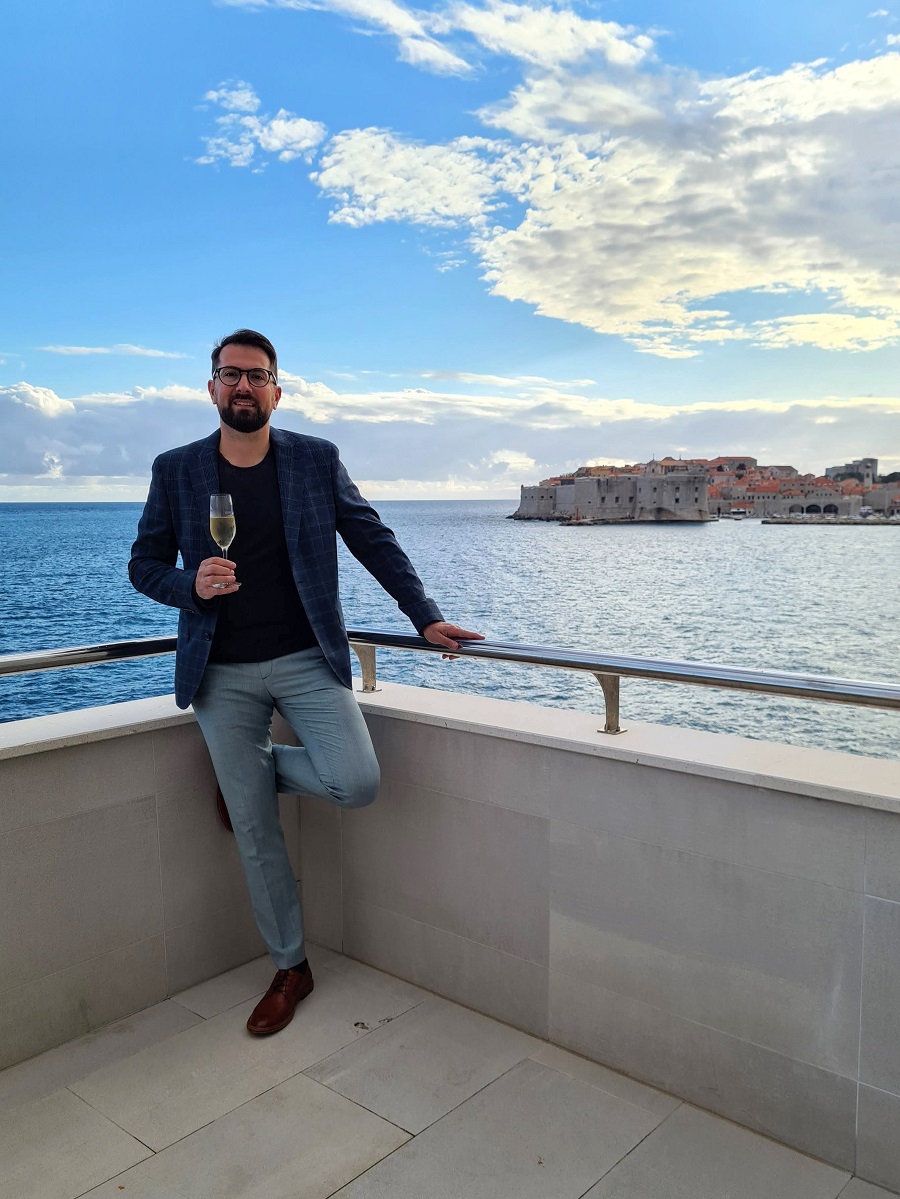
3. How do you see Split as a destination 10 years later compared to back then?
It is easy to call it a missed opportunity, but history does not move forward in such a linear direction. Things are way more complicated, and I refrain from offering simple answers to complex problems. There have been so many externalities that one could not have predicted back in 2012. Covid-19 is one example that many would cite as the defining global event of the past ten years. Another one, perhaps even greater than Covid-19 is the role of social media in the life of a destination, a restaurant, or a hotel, and that rise of influencing fast-changing trends. Then there is the entire change in the demographics on the side of the consumers, as well as on the side of the providers, and the industry, globally losing the appeal it had for many young people as the industry of choice. I could go on with the global changes that affected us full-on, despite us being on the map only tangentially in relation to the epicenters of those changes.
Then, you have a whole host of national externalities that are outside of the reach of Split’s jurisdiction, from well-documented administrative loopholes to the fact that the apartmanization has been seen as a sort of a social welfare system, avoiding the introduction of the property tax, and even taxing the apartment rentals at such a positively discriminatory rate, that any other investment seemed foolhardy. On the other hand, we have seen a roulette of tax codes in the restaurant industry moving from 22% to 23%, to 24%, to 25%, to 10%, to 13% to 25%, or some sort of that combination. Anyway, this is not to say that the local industry and the local politicians are not to blame, but truth be told, it was a whirlwind of learnings and failures on the part of the industry, with many having absolutely no previous experience and having to learn overnight in an often hostile environment, producing a barely edible, partially overcooked, but mostly undercooked mix of everything, garnished with a significant number of short-term speculators and a side dish of a non-edible mash of political shenanigans.
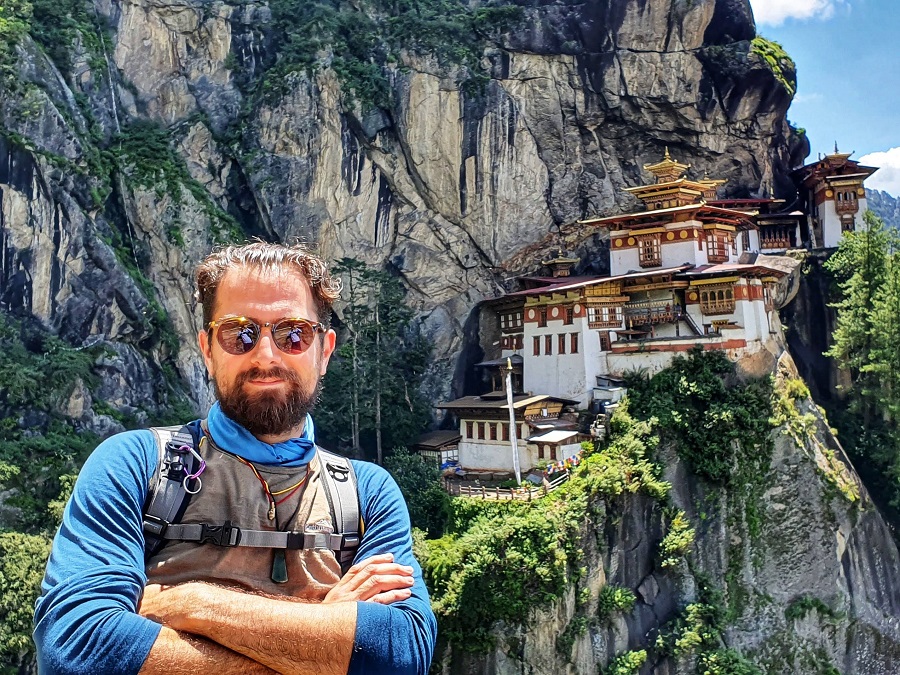
Sure, I would have loved to see how Split would have developed should Marjan have opened in 2014 or so, as announced back in 2012, bringing the large-scale yet upscale operation to the city with the greater off-season and MICE opportunities, with Hotel Amabasador following suit, with Bellevue being the flagship historical hotel, with Villa Rossina pushing the boundaries in the luxury villa accommodation, with some of the Žnjan hotels coming to life and so on. That could have pushed the city wider and longer, spatially, and timewise, relieving some of the pressure on the historical center as well as dispersing more travel to the low season.
To answer your question, Split of today is a mish-mash of everything, that attracts a mish-mash of guests, without clear destination branding, without the industry coming together in some cohesive manner, but a destination that yet can deliver over many decades to come.
4. Split has changed enormously in the last decade, with an explosion of tourism, a lot of it a younger crowd with access to cheap alcohol and pub crawls through the UNESCO World Heritage Site of Diocletian's Palace. What are your thoughts on this?
What can I say? It is not my crowd, and it is not how I develop my businesses, but these are the guests we have today, partially due to our failings, partially due to the pent-up demand among the young people being locked up for a couple of years. Some people are behaving like there is no tomorrow. This is more than a Split problem. As long as they are behaving within the legal bounds, I can’t fault them. I am not the one to throw moral judgments around. I don’t believe that drinking yourself into oblivion and losing memories tend to make people happy, but that seems to be the name of the game for many young people in these months following the two-year pause on social life. Some of it will go away naturally, some of it we will have to forestall with clearer communication, and some we will have to convert to different types of activities and tourism. That is the part that rests heavily on the shoulders of the industry leaders in the city.
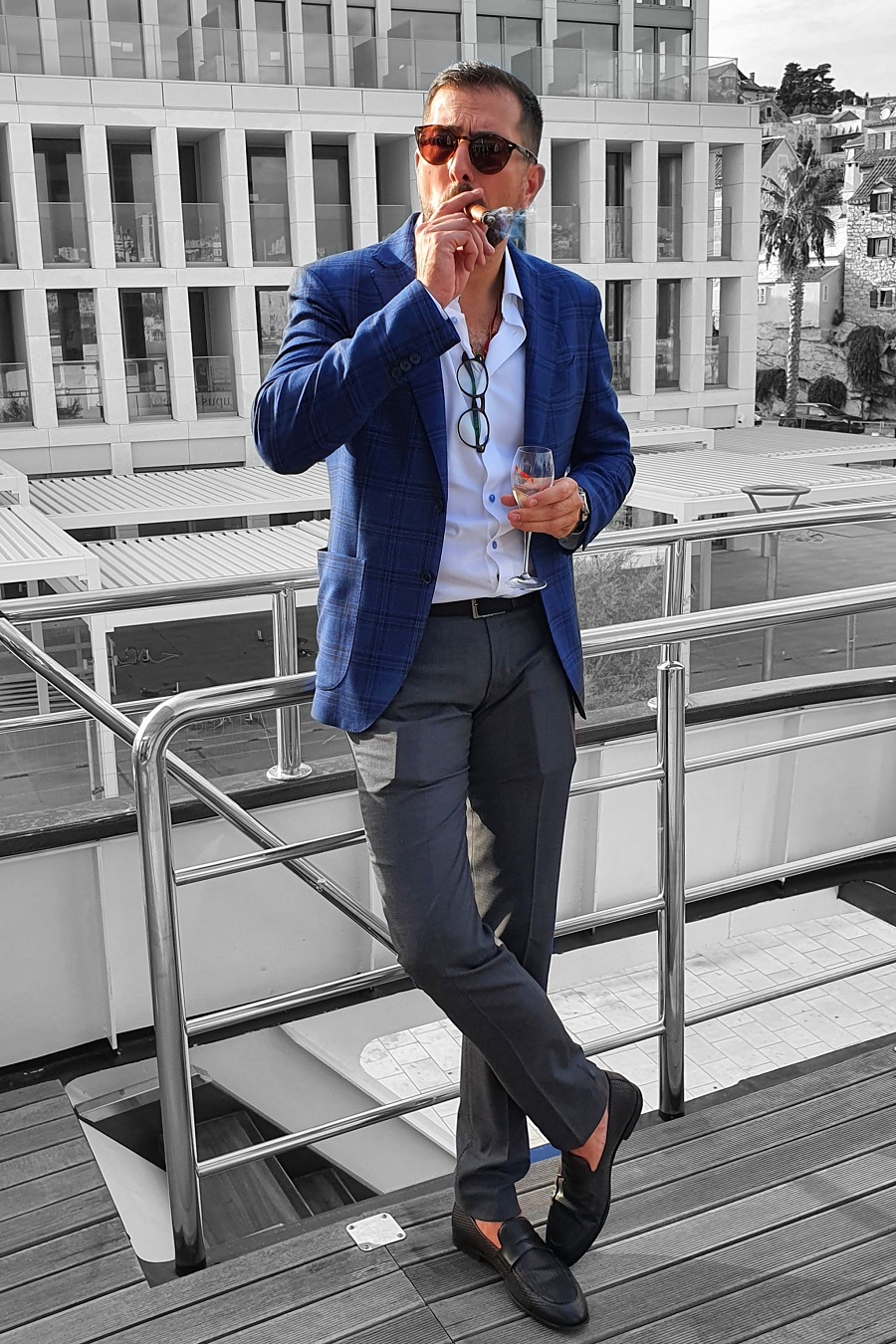
5. Several people point the finger at Ultra Europe for starting this. Do you agree? And if not, why not, and what is responsible?
That would be exactly what I said earlier, explaining the complex situation with a simple answer and pointing a finger at everyone’s favorite villain. I think that I have explained the confluence of different trends, externalities, and local failures in some detail already.
6. What kind of destination should Split be, and what is the ideal profile of tourist?
There is no such thing as the ideal profile of a tourist. Things change and evolve and what a typical upscale traveler looked like twenty years ago, how they look today, and how they will look like twenty years from now are completely different.
Split is not a little coastal town. It is the largest city on the Eastern Adriatic, and it needs to attract all different sorts of tourists and play on all of its main points of distinction, from the historical and cultural backgrounds to the extremely favorable geographical positioning, to sports, and music and gastronomy. Split needs to lead the way, and the only way it can achieve that is through education, formally with better hospitality schools, and informally through the successful stalwarts of the industry, aka internationally recognized hotels and restaurants that are pushing the boundaries of service excellence, firmly rooted in the continuity of living and sense of place that is our key point of distinction. We need local heroes of the industry, but also we know how Split treats its heroes often, so perhaps we skip that recommendation.
It takes decades to achieve this goal, while the goal keeps changing. I understand that this may sound like a word stew that means nothing, but that is the best I have to offer right now.
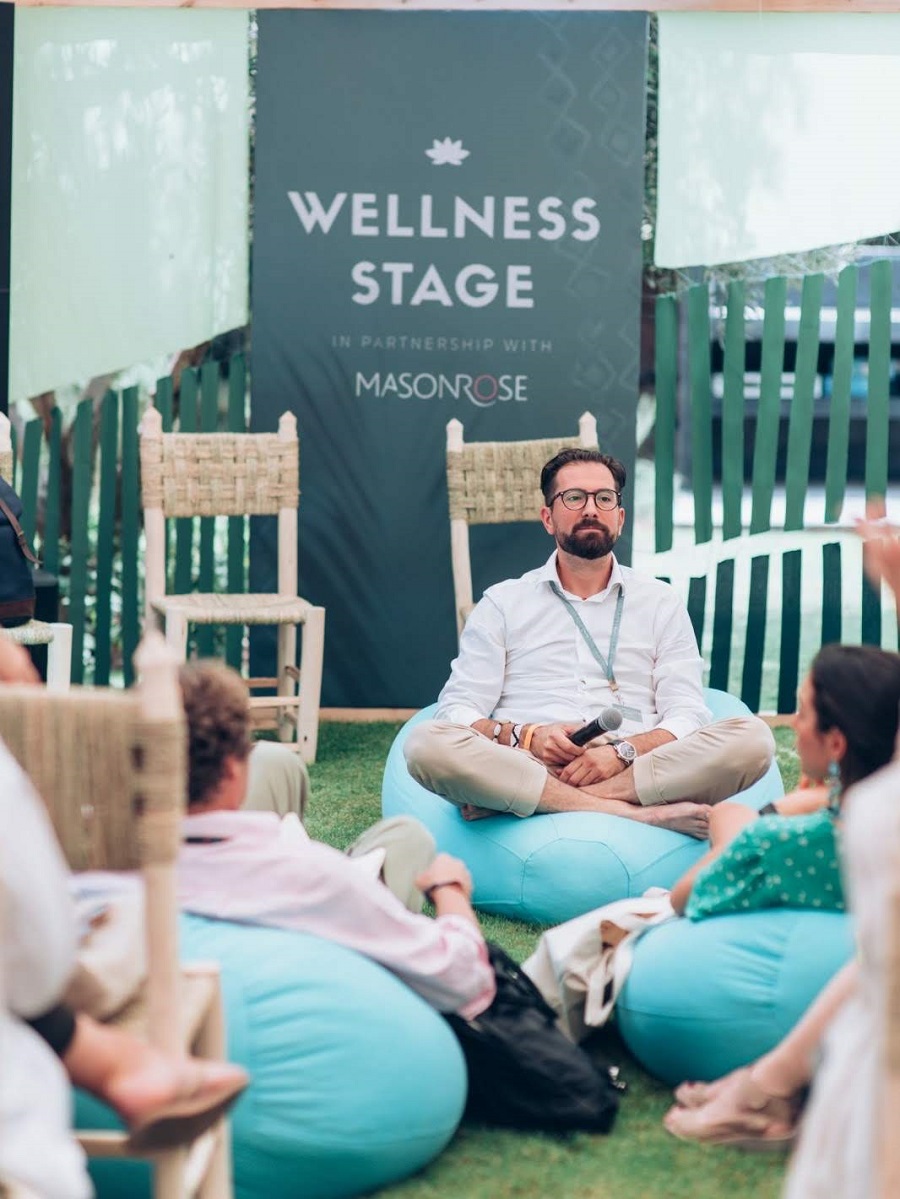
7. You are the Mayor of Split and Split Tourist Board director in one. Tell us what your strategy is to develop the city's tourism.
I will share these thoughts directly with the Mayor of Split.
8. 3 quick wins to improve the current situation?
If you are referring to the recent scenes from the historical center of Split, that can be partially mitigated with a clear communication campaign, meetings with the stakeholders that are propping up this behavior, and enforcing stronger rules with better policing. However, that is not something I think about that much. I am much more concerned about the ways in which we can regain some of the attractiveness as the industry of choice, especially for the young people, which largely sit on the shoulders of the industry; how can we attract more mindful hotel developers, with long term vision and respect for the local community to invest in our city; and how can we fix the existing infrastructural challenges that are causing the same pains for the local and the tourists alike. The other two aspects are something the industry without the help of politics can’t achieve.
9. How do you feel about the direction of Croatian tourism? Is it on the right path?
Someone once said that it is better to use a compass than a map to reach the destination. Well, we never had a map, and the compass is often broken, so we are a bit lost in the storm of other people’s making, and our inability to take control. We are kind of heading in the right direction, but moving very, very slowly. Some people have shown us the way. Here I mostly speak of the winemakers, olive oil makers, and to an extent, the cheesemakers. You might wonder why I bring the world of agriculture when we talk about tourism, but that is exactly our point of distinction: tourism that is born out of agriculture, and the one we don’t see yet, and I hope we get to see, agriculture born out of tourism.
And education, of course, education…
10. And finally, what is Zoran Pejovic working on next? I know you can't sit idle for long...
There is so much going on, some days I feel like I am on a rollercoaster of calls and meetings on future projects. I might have to venture outside of Croatia for a bit, most probably Norway and the USA, as the projects that are in the pipeline in Croatia are just too far in advance for me to make my living, especially given the past two years and the capitulation of our Split ventures under the weight of the external pressure, Covid-19 closure and our lack of readiness to gamble away our reputation through cost cutting, employee reductions and overall compromise of quality, coupled with the internal inability to carry on financing the old ways indefinitely. There are a lot of scars from the past two years, so some international exposure is needed to expedite the healing process, before returning to deliver another flagship project to Croatia, the way we delivered Maslina Resort on the island of Hvar, or the way Paradox and Paradigma led the way in the development of Split’s wine and gastronomical scene.
You can follow Zoran Pejovic on LinkedIn or find him on the Paradox Hospitality website. He is also an occasional contributor to TCN and wrote some excellent articles about tourism during the pandemic.
Read more on the current state of tourism in Split:
Is Split Tourism 'Strategy' Killing the Goose with the Golden Eggs?
ULTRA Europe Festival's Joe Basic Talks Split Tourism Development.
****
What is it like to live in Croatia? An expat for 20 years, you can follow my series, 20 Ways Croatia Changed Me in 20 Years, starting at the beginning - Business and Dalmatia.
Follow Paul Bradbury on LinkedIn.
Croatia, a Survival Kit for Foreigners will be out by Christmas. If you would like to reserve a copy, email This email address is being protected from spambots. You need JavaScript enabled to view it. Subject 20 Years Book
ULTRA Europe Festival's Joe Basic Talks Split Tourism Development
August 9, 2022 - Last week's TCN editorial, Is Split Tourism 'Strategy' Killing the Goose with the Golden Eggs? caused a lot of discussion. Now listen to the viewpoint of one very switched-on stakeholder, ULTRA Europe Festival founder, Joe Basic.
It takes a lot to succeed in Croatia, especially when you are bringing a new product. And especially when that product is the largest music festival on the Adriatic coast.
Canadian Croat Joe Basic returned to the Homeland over 25 years ago to try his luck in the newly independent Croatia and to do his bit to help shape the country's future. Despite many falls along the way, he has achieved considerable success, the most notable of which is undoubtedly the ULTRA Europe Festival, which will be celebrating its 10-year anniversary next year (9th edition, with a break during the pandemic).
Unlike the majority of expats living in Croatia, both Joe and I well remember how Split was ten years ago. It was the year I started Total Split, which was the first meaningful portal in English about the city, with many places written about for the first time in English. Back then, Diocletian's Palace was a little bit intimidating, especially off-season, when it became a ghost town with a medium-sized drug problem.
Split itself was better known not as a tourist destination but as 'the Gateway to the Dalmatian islands.' It was undoubtedly beautiful - with a spectacular UNESCO World Heritage Site and Riva just metres from the ferry - but a far cry from what we see today. Joe, meanwhile, was busy trying to put his country - and particularly Split - on the global map.
Something that the ULTRA Europe Festival most certainly did.
And so, for a few days in July, the Dalmatian capital gave way to the ULTRA party, which attracted 75,000 people in the first year, and which has been growing ever since. Nine years later, Split is beyond recognition as a destination, and the current problems with drunkenness, nudity, and anti-social behaviour are the cause of much discussion. Some point the finger of blame at ULTRA, saying that everything went downhill from there.
I disagree. And for those who have followed me for 10 years, you may recall how against ULTRA Europe I was on my adopted island of Hvar. But for Split, I think ULTRA has been a good thing. It would have been even better if the biggest problem that has arisen had a solution in place - a strategy and operational plan to manage the rapid growth in tourism. Such a thing does not exist, and that is the main cause of Split's current issues. At least in my opinion.
And the good news is that things are solvable. I have little faith in the current Split Tourist Board, which has been worshipping at the temple of numbers, numbers, numbers for years without coming up with any kind of discernible strategy. But I do have hope in the new mayor, Ivica Puljak, who has recently been returned to power with a much stronger mandate, after calling a snap election to strengthen his position earlier this year. Mayor Puljak's active participation in the TCN Split Winter Tourism Roundtable initiative is evidence of his involvement and positive engagement.
I thought it would be useful for the debate to get the perspective of Joe Basic. As the man who brought the ULTRA Europe Festival to Croatia and Split, he is very well-positioned to comment. He also understands the scene and the Croatian way much better than I do. Additionally, he understands the trends and can clearly see where Split is going wrong - and how to (relatively easily) fix it. I will be tagging Mayor Puljak and the Split Tourist Board when I publish this, in the hope that they will take on board Joe's insights and recommendations.

A Canadian-Croatian returnee, it was only when I sat down with Joe that I realised what a proud Croat he is, and how much he is working on several fronts for a better Croatia.
Our conversation took us back a decade, a time when Split was not recognised globally or in Europe as a travel destination. Back then, Split was seen as the biggest Croatian city on the Adriatic coast, a city known for its sports teams Hajduk, Jugoplastika, and the home town of athletes Goran Ivanisević and Blanka Vlasić. A city people only visited on their way to other destinations such as Hvar, Bol or other Dalmatian islands connected by ferry in Split. When the ULTRA Europe Festival was presented as an event to be organised In Split, many locals commented that they could not see how this event could be organised here, and that there were many other locations more attractive than Split for this event.

Split was a VERY different place to today. The average stay for tourists was less than two days, and as I pointed out in last week's editorial, there were less than 5,000 registered private beds, with hotels also lacking. The spreadsheet above, provided by the Split Tourist Board, shows just what an (uncontrolled) explosion there has been, particularly in private beds.
According to Basic, the ULTRA Europe Festival recognised that Split offered an attractive destination with access for guests from around the world by plane, car, train, boat and other means of transport. As the largest city on the coast, it ensured potential local support and attendees of the event. With its historic old town, beautiful sea views, beaches, and other attractions, it provided the opportunity to create the first destination music festival where guests not only attended the music festival but had an opportunity to experience all that the destination offered. A chance to maximise the overall experience of festival goers with all that the city of Split offered.
Pulling off the first ULTRA Europe
Given the fact we live in a bureaucratic country where foreigners have to produce an original birth certificate no more than 6 months old for their annual residence permit renewal, I can only imagine the nightmares he must have had pulling this off for the first time.
Basic explained that initial support from local authorities to organise the first ULTRA Europe Festival was minimum and almost zero. The city of Split and other government authorities did not financially support the event and ULTRA had to organise everything. The city did not have the infrastructure to support events of this scale, and as a result, ULTRA needed to secure equipment from all over Croatia and Europe. Local services and agencies, including security, cleaning and others, did not have the required number of staff, so they were sourced from other cities, thereby increasing the overall costs. Transfer vehicles, hotel rooms, and presidential suites in 5-star hotels were limited and/or non-existent, making it difficult to meet the expectations of artists arriving to perform at the ULTRA Europe Festival. In the first year, there were over 75 000 people attending the event, in a city with less than 200 taxis available. And of these, very few offered their services after midnight. Today, there are over 2000 taxis are in the city of Split during the ULTRA Europe Festival.
People who arrived to attend the ULTRA Europe Fetvial in 2013 from around the world were, for the most part, introduced to Split and Croatia for the first time. Most people had never heard of Split and were coming to attend the ULTRA Europe Festival, not visit the destination. For instance, many people who attended didn't even know Split was a coastal town with beaches and arrived without bathing suits. No matter how much Croatians believe everyone in the world knows about Croatia and Split, this was certainly not the case In 2013, especially in countries outside of Europe. Basic says he and his team spent a lot of time and money presenting and promoting the destination worldwide to inform and educate our attendees about the destination.
What was the ULTRA Europe effect?
The ULTRA Europe Festival was very controversial when it first came, but Split locals quickly got to like the tourism boom it brought for a few days in July. I asked him about 'the ULTRA effect' in Split during those festival days, including some numbers.
He told me that the ULTRA Europe Festival is very powerful as it generates a high level of awareness globally, generating over 200 million impressions which present Split and Croatia in an attractive manner. It has branded the City of Split as a leading global destination, and today it is clear that Split and Croatia are definitely more well-known, and the ULTRA Europe Festival has a lot to do with this, especially in the young adult segment (18-35). These are the most sought-after tourists in the world and most difficult to attract as they seek relevant and trendy activities to animate them. At the same time, they tend to generate the greatest financial impact as they spend more than the average tourist. This higher level of expenditure and increased intensity of activities when visiting generates a higher level of impact as these guests seek more while visiting. For instance, according to Basic, boat excursions and taxi boats In 2013 compared to 2022 have increased 1000%. Taxis, restaurants and other activities have all grown 10X since the first ULTRA Europe Festival. The average night cost less than 50 EURO in 2013, whereas today the average room is over 200 EURO, with rooms in hotels costing more than 350 EURO / night during the ULTRA Europe Festival.
In 2013, the first two weeks of July were known as SRPANJSKA RUPA (the July Hole/Gap), where there was a drop in tourists and occupancy numbers. This would increase and peak in the season starting after July 20th to the end of August. This was a problem for hotels and apartment owners, and for this reason, the second weekend of July was chosen for ULTRA Europe. Today you have 10x more capacity, and you are unable to find a room in the first two weeks of July. It is now considered to be peak season for many hotels and other accommodations in Split, based on the average price per night. This is not true for other cities in Croatia, such as Dubrovnik, Zadar and Rovinj.
What about the perception of Split as a destination 9 years later and the ULTRA effect on that?
Basic answered that the image of Split has changed immensely since the ULTRA Europe Festival started. It has become a global destination recognised as a vibrant city and a perfect destination to visit. This is especially true for young adults as the ULTRA Europe Festival has made this more attractive and welcoming for these guests. Over 1 million people have attended the ULTRA Europe Festival since 2013, and the positive experience and word of mouth promoting this destination from these guests alone have created a tremendous amount of interest to visit Split. It needs to be recognised that young adults (18-35) are the hardest target group to attract to any destination. They are a target group that tends to spend the most on average and are especially valuable guests as they will repeat their visits over an entire life span, returning with their families and children later In life. Typically, destinations in the world who can consistently attract young adults are those destinations which will become leading world destinations recognised for being trend-setting and top of mind in the world.
Basic also believes that the ULTRA Europe Festival has also been a catalyst in generating changes in the overall offer In Split, with many new restaurants, cafes, shops, hotels and other openings catering to an international market. This was not the case before 2013. When comparing Split to other coastal cities in Croatia in the period since 2013, Split has changed much more by far in its overall offer than any other city.
Which brings us to the problems of today and a younger crowd with access to cheap alcohol and pub crawls through the UNESCO World Heritage Site of Diocletian's Palace.
Basic explained that Split has become a GLOBAL TOURIST DESTINATION attracting guests of all ages seeking a vibrant and attractive place to visit. No longer is Split a transit city, where people do not wish to stay and visit. It has now become a primary destination when visiting Croatia. With average night stays exceeding 5 days from less than 2 in 2013, Split has truly become a destination of choice for travellers from around the world. The fact that young, hard-to-attract travellers are visiting Split is a confirmation that Split has become an attractive destination, offering something special and unique. ULTRA has definitely helped to generate this interest and draw people to Split, highlighting its old town, beaches and other attractions in a modern and attractive manner. Basic believes this is what every destination seeks, and this success should be recognised as a positive and not a negative result. However, issues being experienced today in Split are common issues with any city transforming itself and dealing with the changes required in a process of change which Split has faced in the last 10 years. This amplitude of change has happened In Split much quicker than typical due to the high interest the ULTRA Europe Festival generates each year for Croatia and Split. However, it is something that can be managed and is In the interests of all as they transform and improve their overall potential and financial prosperity.
This growth needs to be managed and a strategy defined and put into place to determine what Split desires to become. At the moment, no clear strategy exists, especially a strategy that will unite all key decision makers. The changes occurring are beginning to reveal the weaknesses. One example of this are young adult visitors who are coming to visit Split for a weekend of drinking and low-cost fun. With Split now being recognised as a cool and trendy destination to visit for young adults, tour operators are taking advantage of this and organising trips to Split, focusing on bringing In as many people as they can for the least amount of money. With communication like „THE BEST NIGHT YOU WILL NEVER REMEMBER, “ it is clear that the interests and positioning of this type of event are not In the interest of the City of Split or Croatia. This is the least attractive type of guest for any destination as these guests simply seek to come for 3-4 days, to spend as little money as possible while getting drunk with their friends.

These tour operators are not investing any money or organising anything in the destination; they are simply using the destination and negotiating the cheapest deals possible to maximise the number of attendees. This includes famous PUB CRAWLS, which attract young adults to drink as much as possible for less than 30 USD In 2 hours. ULTRA Europe Festival guests coming to Split on average are spending over 3000 EURO to travel and visit Split. These PUB CRAWL guests are coming to Split trying to spend less than 250 EURO for 3 days of partying. These tours present the worst of Split by bringing people to C-category venues, offering questionable alcohol, and encouraging people to get drunk as quickly as possible. The more the merrier, without any controls in place with security guards or registration of events with city.
By law, events in public places with more than 40 people are required to be registered, and an organiser and responsible person must be defined. Approvals and registration of this event are needed to be allowed to operate, and the organiser needs to have all the required documentation, insurance policies and good standing with tax authorities, ZAMP and others to guarantee a safe and responsible event. Unfortunately, this is not the case with PUB CRAWLS In Split, and organisers are taking advantage of this and basically raping the city as a result of its current popularity, leaving behind all that destinations want to avoid. This is similar to a town where gold is found, attracting people from all over the world to get rich, mining the rich ore while it lasts, not concerned with what is left behind. However, cities and countries where gold mining is regulated and managed invest and develop themselves, prospering from the riches mined and are successful well after all the gold has been mined.
Below are examples of the positioning and offers being presented by organisers of PUB CRAWLS. This is the lowest possible offer that can be made for visitors to Split and is something that is not representative for the city and is potentially dangerous, as these events are being organised without a responsible person or entity. You also need to ask yourself how taxes are being paid for these organised pub crawls.
Basic was keen to point out that as an organiser of the ULTRA Europe Festival, he is responsible for ensuring that his guests are supported and safe. This requires big investments in production, infrastructure and security. Without these investments, approvals and other such things, he would not be able to organise the ULTRA Europe Festival. PUB CRAWLS are below the radar and are being organised without any approvals and infrastructure, and the security required to support this is not being invested and/or required. As a result, this is now out of control, and issues are occurring. This needs to be regulated and or stopped as it is damaging to the city of Split and for all those trying to develop quality and responsible development of the City of Split into a respectable and attractive destination.
Is ULTRA Europe partially responsible for the direction Split has taken?
All the above makes a lot of sense, and the issue of no plan or strategy was one that consultant Mario Seric homed in on during my editorial. But was the ULTRA Europe Festival at least partially responsible for the direction Split has taken?
Basic answered that ULTRA was responsible for generating a high level of interest for Split and Croatia, with over 200 million impressions being generated each year and over 35 million in promotion and advertising to attract people to come to Split for the ULTRA Europe Festival. However, ULTRA is not responsible for the issues the city is now experiencing. This is occurring because nobody is managing or controlling the rapid development of the city into a global destination. Since 2013, the infrastructure and people managing tourism in Split have not changed, while the number of beds registered has increased from 4000 to over 40,000 (see the spreadsheet above). No strategic investments in the city have been made to support or improve the visitor experience by the city, including public washrooms, water stations, or signage. These are crucial investments required to be made by a city to ensure this increased number of visitors can be managed. For instance, PUBLIC WASHROOMS in the city of Split that do exist are usually locked and closed after midnight. Based on this, where are tourists supposed to go to the toilet after midnight other than in public areas? Unfortunately, PUB CRAWLS for the most part occur after midnight, and the end result is clear. For the ULTRA Europe Festival, Basic is aware of this problem, and as the organiser, he invests each year in providing temporary washrooms throughout the city to give his guests options to go to the washroom when walking home from the venue. He claims to have minimal / no issues with this during the ULTRA Europe Festival.
As a result, a strategic plan needs to be clearly defined, defining what type of destination Split wants to become. Once this strategic plan is defined, it can determine the pace and required investments needed to support this plan. This plan needs to be accepted by the public, and all need to support it in a coordinated method to achieve maximum results to the satisfaction of all participants. When this is achieved, it will also be clear to visitors what expectations are for the City of Split and what it represents. This strategic plan should be organised with representatives from all key sectors of tourism and involve government institutions required for implementation. There is a clear consensus that this is required, and Basic is confident that very quickly a working group of highly qualified and professional people can be developed to tackle the issues the City of Split is facing.
So what kind of destination should Split be, attracting which type of tourist?
Basic thinks that Split needs to become a vibrant and active global destination attracting guests of all ages and walks of life. It needs to become a city with visitors coming all year round to enjoy the historical and cultural attractions the city offers along with organised activities highlighting what makes Split special. The City of Split needs to maintain the importance of remaining a city where locals live and work, as tourists always comment on how friendly and welcoming the people of Split are, while offering accommodations, restaurants and cafes which will make guests feel comfortable. Split needs to focus on international guests travelling by plane, seeking an attractive hotel or b&b, aged between 20-45, who will establish the city as a relevant tourist destination while maximising expenditure while visiting. Split has been able to achieve this in the last 10 years, and now it needs to be supported with infrastructure and support. Without this, it could lose all the benefits gained
I made him Mayor of Split and Split Tourist Board director for a day and asked him about his strategy to develop the city's tourism.
He was quite clear about what he would do. The first step would be to establish a consensus on what the City of Split wants and desires to become in 2 years, 5 years and 15 years. When this is defined, form a working group of qualified and respected people from each sector of tourism to be joined by public offices from the city and county required for implementation, including the tourist board:
- Large hotels
- Medium hotels
- B&B / apartments
- Tour Operator
- Organiser of large events
- Organiser of small events
- Taxis
- Bus Operators
- Day Trips / Excursions
- Boats and Ferries
- Restaurants
- Cafes
- Bars
- Media
- Other
When this working group would be formed, its objective would be to develop a 2, 5 and 15-year strategy within 6 months to be presented and discussed In a public forum for final approval. During this process, public debate in the media would be organised to get a better understanding of what the public desires and to challenge certain options. This process would fllter and ensure that the strategy developed will achieve its required objectives and have the public support it needs for success. Once this is defined, a leader / manager needs to be put into place to take responsibility and ensure that the defined objectives are being achieved, publicly sharing results (good and bad) during the process of development. The success of the manager will be monitored based on results and milestones being achieved. This would include qualitative and quantitative objectives like
- number of guests per month
- countries from where guests are visiting from
- % of accommodations In 5-star hotels available and number of apartments
- Managing surveys and feedback from guests visiting the city of Split
- Promotion and advertising messages to support strategy
- Organisation of events and other to support the development and reinforce key communication
- Required infrastructure
How about some quick wins to improve the current situation?
Only three? Here is what he suggested:
Inspection of how PUB CRAWLS are organised and elimination of the same with regulations and controls of venues.
No tolerance policy
Introduction of a working group defined above with clearly defined dates and milestones for development
Improved communication and presentation of issues, results and requirements with the public to gain understanding and support of the process of change the City of Split is going through.
Being such a key player in Croatian tourism, what were his thoughts on the direction of Croatian tourism in general?
He said that he believed Croatia was doing an excellent job in positioning and developing tourism In Croatia. Based on his work with other countries in the world, Croatia is looked upon as a great example of what can be done. However, during this transition, continual changes need to occur and methodology improved. Instead of focusing on numbers of overnights, shift to average spending by guests. Total nights and return visits need to be monitored and communicated to ensure long-term success. Segmentation and specialisation of the market will occur and needs to be supported as certain destinations will transform themselves to certain niches and will not be for all types of guests. This process of change also needs to be managed and supported properly if it is to be successful
And finally, what next for Joe Basic?
He told me that he is currently working on a number of potential major international acts who have not been to Croatia as of yet to perform in 2023 and 2024. Negotiations are positive, and it is clear that these artists desire to perform in Croatia, which is a pleasant change, as it was very difficult to convince major artists in the past to consider or accept Croatia as an option.
You can check out the ULTRA Europe Festival website and reserve your spot for 2023.
Read more - Is Split Tourism 'Strategy' Killing the Goose with the Golden Eggs?
****
What is it like to live in Croatia? An expat for 20 years, you can follow my series, 20 Ways Croatia Changed Me in 20 Years, starting at the beginning - Business and Dalmatia.
Follow Paul Bradbury on LinkedIn.
Croatia, a Survival Kit for Foreigners will be out by Christmas. If you would like to reserve a copy, email This email address is being protected from spambots. You need JavaScript enabled to view it. Subject 20 Years Book
Need A Tourism Break? Five Ways to Escape the Summer Crowds in Split
August 6, 2022 - If you're looking for a break from the summer crowds in Split, we don't blame you. But that doesn't mean there aren't ways to escape.
Split tourism has been a bit... different this summer. With crowds larger than ever (it seems) and very little control over them in the UNESCO-protected center (you can read more about that here), the Split tourism bomb has well and truly gone off this season, and we still have a ways to go.
With travel returning after the pandemic and a season that started earlier than ever, it's felt like summer in Split since Easter - with sunny and warm days to boot. But Split's historic core isn't necessarily adapted for hordes of tourists (we don't think Diocletian had this in mind), making the center almost unbearable at times as swarms of sweat-drenched travelers make their way through narrow cobblestone streets.
Fortunately, Split is much larger than its Old Town, and if you want a break from the buzz, we have you covered.
So, how to beat the crowds in Split?
Marjan
Okay, we know this is a foolproof answer, but that green hilltop known as the city's lungs actually serves a great purpose for those looking to stretch their legs in nature. Best in the early morning for a hike up the hill, followed by coffee with Split's best view from Vidilica, or at sunset for a swim at many of its beaches, Marjan has always been a go-to for locals looking for a slice of peace during summer tourism chaos. Rent a bike to ride around, strap on your walking shoes for a sunset stroll, or post up at Bene beach for the day surrounded by pines and the buzzing of cicadas.
Shopping malls
Did you know that Split has 3 (air-conditioned) shopping malls, all a short drive outside of the city center? We know that shopping malls might not necessarily be high on your list when you're here to visit a 1700-year-old Roman masterpiece, but if you're looking for a break from sightseeing and need a minute to cool off, Split's shopping malls are not a bad place to be. Joker is the closest to the city center, about a 15-minute walk (which we don't suggest in this heat) or a 5-minute taxi ride. Mall of Split and City Center One are a bit further outside the center but still less than a 15-minute drive. Not only does each shopping mall offer an array of brands, but you'll find extra-air-conned cinemas, content for kids, and fun food courts. Again, we know it isn't the best option, but desperate times call for desperate measures when it's 35+ degrees Celsius. Treat yourself.
Bura Line - Slatine
My favorite getaway this summer is hopping on the 9:30 am Bura Line and heading to Trogir for the day. But only because my parents live nearby. Trogir is no better with crowds this summer, but one stop on the Bura Line is still a safe haven this summer - Slatine on Čiovo Island. A 30-minute boat ride from Split to Slatine has you on the beach in no time - and for only 30 kuna! This small fishermen's village and low-key tourist resort located on the northeastern side of the island doesn't have too much to offer. However, it boasts several stunning beaches, the most beautiful of which is Kava, just 1 kilometer from Slatine town. The Bura Line offers four connections daily in the high season, allowing travelers to comfortably spend the day away from Split.
Museums
Tourists may not take enough advantage of Split's museums, and there are many to explore. Split's most prized museum is undoubtedly the Meštrović Gallery, located around the bend from Sustipan park and conveniently behind Ježinac, allowing visitors to mix the work of 20th-century sculptor Ivan Meštrović with a swim. And if you are looking for something more central? Don't miss the interactive and immersive Museum of Illusions, or stop by Split's oddest institution - Froggyland. Who knows, you may discover a new love for taxidermy frogs? Pro tip: If you're looking for a quick but unmatched Virtual Reality experience of Split and its fascinating Roman history - you'll need to set aside 15 minutes for Diocletians' Dream!
Day trips
We know you're here to visit Split, but its surroundings are spectacular and shouldn't be missed. If you want to keep it local, head to the ancient ruins of Salona in the town of Solin, easily reachable by Promet bus from HNK (to Širina) or taxi (both around 15-20 minute ride depending on traffic). Klis Fortress is also just 12 kilometers outside Split and reachable by local bus or taxi. Open every day from 8:30 pm to 10 pm, don't forget that your ticket price also includes a visit to the Interpretation Center at Mejdan Square and the Stella Croatica ethno-agro park, where you can taste homemade olive oil and local traditional products for a 'multi-sensory experience of Dalmatia’s heritage.' And should you get really hungry? The Stella Croatica tavern offers local Dalmatian dishes served in the courtyard of the estate’s central square!
For more, make sure to check out our dedicated travel section.
Is Split Tourism 'Strategy' Killing the Goose with the Golden Eggs?
August 4, 2022 - It has all the ingredients to become one of the top destinations on the Adriatic, but is the lack of a Split tourism strategy killing the goose that lays the golden eggs?
And on the Seventh Day, God created Dalmatia.
It really is one of the finest places on the planet.
Some time later, a retiring Roman Emperor decided to embrace the fjaka lifestyle in his declining years and built a retirement home. Diocletian's Palace became a UNESCO World Heritage Site and is one of the finest attractions on the Adriatic Coast.
And slowly, over the centuries, a magnificent city started to emerge around Diocletian's final home, which was constructed over 1700 years ago.
Fast-forward to the 21st century, and Split had all the ingredients to be a world-class tourist destination. Just consider.
Diocletian's Palace and the magnificent riva as centre stage; the majesty of Marjan, the lungs of Split, for greenery and escape into nature (where else can you rock climb past ancient churches carved into the rock just outside the city centre); a vibrant arts and culture scene with museums galore, including world champion exhibits, such as the celebrated sculptor Ivan Mestrovic museum; island hopping heaven to Hvar, Brac, Solta, Vis; a diverse gastro scene including the gateway to Croatia's 130 indigenous wine varieties (the original Zinfandal comes from right next to Split Airport, a modern airport connecting to 100 destinations in the season); the de facto digital nomad capital of Croatia with a vibrant remote work community.
I could go on. Split is a destination which has EVERYTHING. Both God and Diocletian chose well.
So how, in 2022, did we come to this?
(Screenshot of most-read articles on Dalmacija Danas portal)
One tourist urinated on a homeless man, another filmed. Then a man from Split saw it.
How I stopped an idiot urinating on a homeless person while his friend was filming.
2022 was the year I stopped focusing on Croatian tourism. There is only so much you can say about the country's one-dimensional strategy of sun, sea, and numbers, numbers, numbers. Besides, there is nothing really new to write about Croatian tourism after 10 years, and the Croatia away from tourism is WAY more interesting, fun and positive - Enjoying a Croatian Summer with No Tourism or Coast: Bliss!
But the inbox will not let me be, and I have had a steady stream (increasing a LOT in the last week) from locals, expats and tourists, all writing about one topic, and one topic alone. Could I research and write an article?
The decline of quality in tourism in Split.
Numbers, numbers, numbers. While the Kingdom of Accidental Tourism talks about the importance of sustainable tourism, it all comes back to numbers, numbers, numbers.
I spend little time in Split these days, but it is a city I know quite well, having started the Total Split portal back in 2012 and co-written the first modern guidebook for city back in 2013 with Mila Hvilshoj - Split, An Insider's Guide. There has been an uncontrolled explosion of tourism in that decade, but the profile of tourism has also changed. As has the tourism offer.
I was quite shocked to see the rise in pub crawls around the Roman Emperor's final resting place. The once majestic and upmarket Marmontovaarea has been transformed into a drinking, urinating and vomiting hot spot, with one big club just off it, a huge one about to open on Marmontova itself, fast food and booze shops now dominating the shops where more exclusive shopping used to roam.
I have been sent videos of a couple openly having sex in a club, as well as THAT 6-minute video on the streets of the palace, of a couple pleasuring each other, she by performing oral sex, he manually to the girl naked from the waist down. In public and in broad daylight.
This is the first in a series of articles on the issue, and this one will be 95% in the words of those directly involved. This includes voices from my inbox, Split tourism expert, Mario Seric, Director of the Split Tourist Board, Alijana Vuksic, and the Mayor of Split, Ivica Puljak.
The aim of this article is to highlight the issues and to show the decision-makers that change is possible. The situation might look terrible, but actually some firm and decision action now can get Split back on track relatively easily.
Voices from the inbox and Facebook groups.
From what we see around, the groups of 20 yr olds that came to party and are disrespecting the town (loud, leaving trash everywhere, drunk, throwing beers on the floor, leaving glasses on windows during the night) are heavily replacing our pre-pandemic type of tourists over 30 with middle to high income that were coming to relax and enjoy Split. The lack of attitude from the City is what brought us here, we have rules but nobody to enforce them, I doubt inspectors fined even ONE tourist walking around almost naked in the old town or for drinking in public. We rarely see local police patroling at night...we are truly genuinely worried that we need to pack up and move somewhere else entirely or find a business model that caters to 20 yr olds, because I do not see this getting better with literally no action from the authorities, and although I read the deputy mayor saying we do not need more tourists, we need better quality ones, so far it is just an empty statement and if no signal is being sent NOW, the next season will be even worse. We had better sales in June than we do in July (makes sense, youngsters were still in school and did not yet fill our town to full capacity). We had worse sales days in July this year than in 2021 and about 50% less than in 2019.
The change in and around Marmontova is terrible. You have 305 club on Trogirska. Total nightmare already. Many articles written already about youngsters peeing and pooing and vomiting around. From 9 pm all we see around us are youngsters some already intoxicated. And the huge space that was the Bershka shop on Marmontova is being transformed into the biggest club in the old town. I am afraid the new Marmontova club will be the straw that broke the camel's back. Marmontova itself that was a classy charming street with higher-end or at least ok quality shops, is now full of fast food and booze shops.
Meanwhile more bars are catering/encouraging drunkenness, 1L "Cocktail Buckets" and ` Happy Hours`. Hostel owners bemoan the drunken idiotic behavior of their guests.
I have been living in Split since May 2021 and came for a visit in fall 2020. So all to say I don’t know what tourism looked like pre-pandemic. I truly love it here but July and August put that in question particularly this year. Though I love the city coming to life, I question the type of tourism that Split is going for as I see rather high numbers of tourists still drinking at 5 am from the night before on the streets. The lack of respect and clothing in the old city. And the amount of trash. Luckily Split has some of the most amazing cleaning crews and by 8…. But this morning, was a whole other level of disgust. Besides the 50+ people from the night before… I was approached and almost sought out (as I was trying hard to steer away from the tourists out) while out with my dog. This person then proceeded to pull out 200 Kuna and asked me for a sexual favor. I was horrified and livid. Feeling almost assaulted at 6 am. There is no good time to enjoy Split right now and it’s sad. I am happy I am here, but the tourists and the direction Split is going give me pause as I look to applying for a second digital nomad permit.
The downtown had a soul but it's dead or dying. Many things changed and mostly in a bad way. We're more like a big hotel than a town. I used to bring my kids for a walk, at least once a week. Now maybe once a month or even less.
As an expat, I don’t find it attractive in summer. We came to Split in winter and not for holidays but to make it home for a year (at least) but it’s incredible how it changes in summer. Suddenly everything is more expensive, restaurants don’t take cards anymore, only cash, noisy and busy as hell, can’t help but feeling like a walking wallet… If I could choose again I don’t think I’ll pick Split.
It's a complex problem. As a home-owner / expat / part-time resident I run away for summer while still wishing I could enjoy the city all year.
The profile of tourists changed as well. Split was always just a day or two transit hub for island hopping, serving all kinds of tourists. The ferry, train and bus station are all next to each other for that reason. Meanwhile, it became a festival spot and tourists are frequently T-shirtless, drunk, puking and pissing around youngsters (bcs they don't understand the Palace is a 1900 y/o monument to respect).
Oh, and another thing we hate this year...because of the dispute on who should charge for the yachts parking on west riva, all spring and summer nobody has been charged for parking there and nobody could use water or electricity. That meant no big yachts came, west riva became the wild wild west with all the local charter boats parking as they pleased....and west riva used to be a beautiful place for superyacht watching
The most interesting (and concerning) part of Split&tourism is how the city center lost its famous and vibrant lifestyle and became a ghost town out of the season (locals also avoid approaching the palace area in the season). It would be a great case study of what tourism should not bring.
And my favourite - ah, Hrvatska...
The reason why “communal officers” can’t charge fines for pissing and other things is that foreigners don’t have a Croatian OIB (personal ID number). Their system can’t recognize the payment. So that’s why they call the police. Then the whole procedure until they take them in front of the judge, if there’s a reason to do that, and only there can they pay the fine.
I asked a friend to list some specific incidents.
Guy wanting to pee on a homeless man.
Guy peeing in the fountain.
Girl pooing in the street vase.
Girl peeing on the street.
Girl giving blowjob on the street.
Couple having sex at Matejuska.
Guy peeing on the street (these must be a normal occurrence, a couple of metres from us where there is a dark spot that smells like a urinal...also last night, I had a Canadian couple tell me they were appalled to see a guy peeing on a monument). I personally saw a very drunk young man touching women's breasts on Marmontova...him and all his friends laughing.
How did we get here from where we were, a stunning cultural destination, with a UNESCO World Heritage Site and Roman Emperor's retirement home at its core?
Rather than give my own thoughts, I turned to a tourism expert who knows the city intimately. Mario Seric is an international tourism expert with a Split address, who has undertaken 169 projects in 16 countries. His knowledge and expertise on Split and destination management were key factors in the launch of the TCN Split Winter Tourism Roundtable initiative earlier this year.
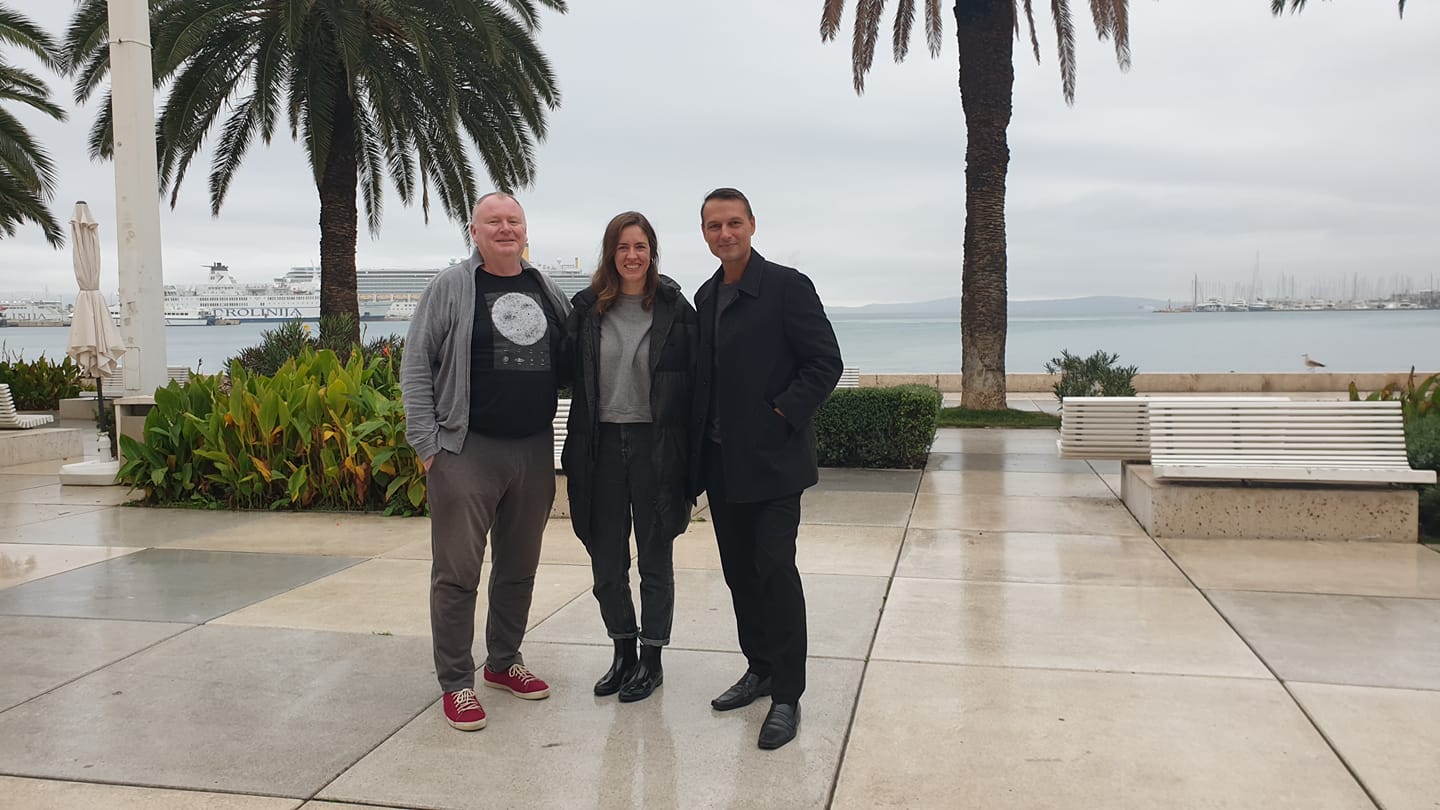
(With Mario Seric earlier this year for the initial planning of the Split Winter Tourism Roundtable)
The situation we have now is the consequence of five factors: no professional destination marķeting, almost no destinaton management, an abundance of relatively affordable apartments and rooms to rent, an abundance of liquor stores (working longer than the bars), imbecile behavior of generation Z as compared to other generations when they were their age.
Split is one of the cities that do not have any professionally done strategic document for tourism, be it a strategic development plan, strategic investment plan, strategic management plan or strategic marketing plan, nor any operational plans that should follow previously defined strategies.
Some documents are done but with limited scope, poor quality, and by persons without the required know-how to do them. The current tourism situation of Split is the result of a lack of the above-mentioned documents and responsibilities to perform the tasks stemming from them.
In conclusion, nobody has ever done anything serious, nor were there people responsible for any kind of execution.
The areas of development and investments (preparation of investments) should primarily be the responsibility of the city government while the areas of management and marketing the responsibility of the tourist board... with strong cooperation between the two and some more parties involved.
No mayor has done anything related to the development and investments, and even if he wanted to, he was soon out of office (constantly changing mayors). The tourist board has been doing more or less standard activities inherited from the 1990s with some modifications, yet tourism has been exploding, but not due to their efforts.
So how is that? It is quite simple. The 2000s were marked by the following factors on the European market: low-cost airlines, interest in visiting city seaside destinations, and interest in discovering Croatia by visiting several destinations relatively quickly. So, in addition to Dubrovnik and Hvar, Split was the one that was filling this hole: it is on the sea, it had some heritage, and it had its airport. So it was a logical choice, and that this how this "golden triangle" was formed (Dubrovnik - Hvar - Split).
More or less the same airlines were flying to both Dubrovnik and Split, thus allowing customers to organize their trips easily; three destinations were a great choice for 5 / 7 / 10 days, usually including Mostar / Krka / Plitvice... And it all started exploding, first with European markets and then with overseas markets. This was Croatia's playcard for the world... Zagreb later benefitted from this as well.. all the same as already experienced in other Mediterranean countries.
And then local entrepreneurs started understanding what was going on and started investing in boutique hotels, hostels, restaurants... this trend then spread to rooms, apartments, clubs... big events started, and the market principles of supply and demand were in overdrive.
And all these with only two big hotels in place (Le Meridien and Radisson)
So there was a tourism explosion without strategic documents and without a critical mass of big hotels. It is actually an interesting phenomenon, but the lack of strategies and hotels have led us to where we are now. More than 80% of beds are in relatively affordable rooms and apartments, while less than 20% in relatively expensive hotels and similar establishments. And that is why we have two very different markets creating a bipolar destination... those who want to have cheap accommodation and eat cheap (fast foods, buying in markets over restaurants) and those who stay in hotels and eat in relatively expensive restaurants.
And the first market segment is dominating the market, especially in July and August when, of course, young people can travel.
And naturally they choose Split... regardless of the music prohibition after 11pm (since 2019) and regardless of the early closing of the bars (since recently), which is actually amazing... Not to mention that these prohibitions do not make any sense... as evidenced by the fact that now we have even more young people creating chaos despite the prohibitions. If they by any chance prohibit alcohol consumption in bars (which will never happen of course) I think we will have even more young tourists as they always find ways to get drunk. Anyway, the youth are not the problem... they are the way they are, but the question is why Split has allowed itself to come to this situation, especially with the cultural heritage that it has.
Ultra Europe is a great event, and it is not the one responsible for this. Ultra contributes a really tiny percentage of guest nights, and it has loyal followers, but is just one of numerous big party organizers.
You have the same parties elsewhere in Europe as well, but they do not necessarily position a certain destination in one direction.
And a few more things I would like to add which I think are important.
Similar things are also happening in other cities in the Mediterranean, even though not to this extent, but with the same market (young people, which is generation Z, i.e. those born after 1996, drinking heavily, behaving without any manners, so some things are actually even generation specific).
Second, here in Croatia, you can easily categorize apartments in residential buildings for tourism purposes, which, for example, in Spain is legally not possible!!! So for example, in Croatia, if we want, we can legally convert the whole of Split into a holiday resort, which, in my opinion is insane.
Give me 5 quick wins for Split tourism.
Quick win 1. Get involved in the 2023 Split Tourist Board budget to clean it up as much as possible.
Quick win 2. Get the financing for airlines for Spring 2023 and November 2023 (at least one airline for 2 or 3 destinations with minimum 3 to 5 flights weekly for each).
Quick win 3. Get the financing for global events for Spring and November (at least one for now).
Quick win 4. Embrace the advice of expats and digital nomads on what should be done.
Quick win 5. Announce the preparation of big investments (for new tourism offerings) and strict yet just regulations (for managing the destination, from stimulating the entrepreneurs, setting up the max number of tourist beds in the city, etc.).
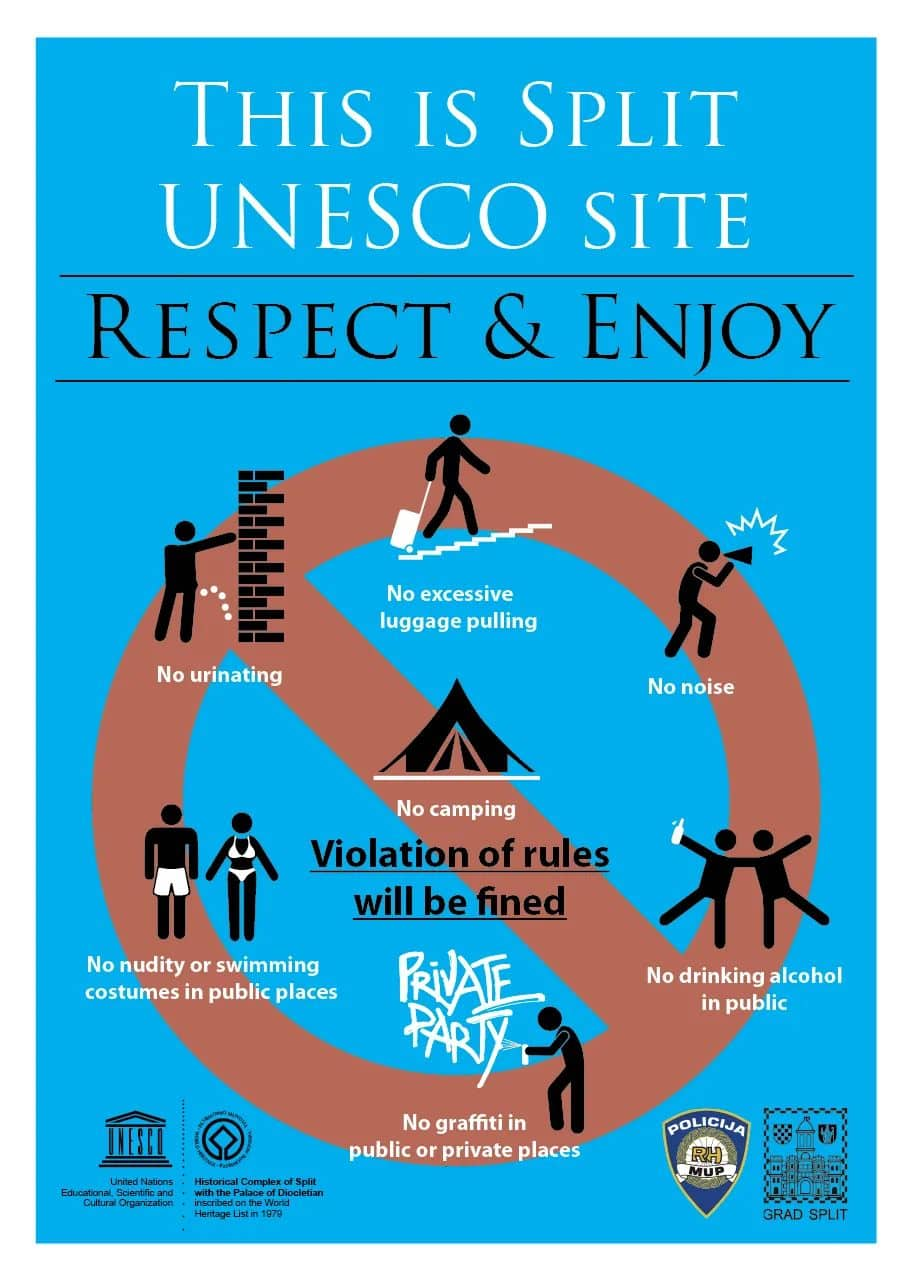
I emailed the Split Tourist Board with some questions on the subject.
Dear TZ Split team,
TCN has received dozens of complaints, mostly from residents of Split, about the decline in quality of tourism in the city, particularly in peak season.
We are currently researching for an article which we plan to publish on Wednesday called
Is Split Tourism 'Strategy' Killing the Goose that Lays the Golden Eggs?
Rather than publish it without your knowledge, I would prefer to get your input. I have the following requests/questions - if you could please send by Tuesday evening, so that I can include?
1. Could you please send the breakdown of beds by year from 2010 - 2022 for private accomm, hotels and hostels, similar to the one attached that you kindly sent me a few years ago?
2. Could you please define what is the strategy of Split tourism in a sentence/paragraph?
3. How would you describe the season so far? Are you happy with the results?
4. Residents are telling us that there has been an explosion of party tourism, with lots more drunkenness, pub crawls through the palace. Is this something that you have noticed?
5. Several residents and expats have told us that they have to leave the city this peak season (unlike previous ones) as it has become unbearable. What message do you have for them?
6. Locals also tell us that they rarely go to the palace these days, as it has become a tourism zoo in the season, and a ghost town out of season, with little local life. Have you noticed anything similar, and what strategies do you have to reinvigorate local life?
7. Marmonotova used to be a prestigious address in the city, and now it is slowly being turned into a bar and club area, with the accompanying debauched behaviour. Do you support this new direction?
8. Recently, new signs have appeared around the centre, see attached - urging people, among other things, not to urinate in the street. Why is this necessary? Surely the type of tourists you are targeting know how to behave and not to urinate in the street?
9. The same signs talk about proper dress and no drinking alcohol in public, or there will be fines. There are many cases of inappropriate dress and people drinking in public. How much are the fines, and how many people have been fined so far?
I will publish your answers in full and would be happy to include a statement from the Split Tourist Board director.
I look forward to your response.
Kind regards,
Paul Bradbury
The Split Tourist Board was kind enough to respond within the deadline. The response in full:
Dear Paul,
thank you for your queries. Attached you can find the requested data, and below in this message are answers to your questions, by Tourist Board director Alijana Vukšić.
Regarding your claim that the number of beds dropped from 2010 to 2022, the data that we sent you before shows the annual rise in the number of beds before 2020. In 2020, due to insecurity caused by the pandemic some rentals were cancelled.
(How accommodation units have increased in Split from 2010 to 2022 - the rise of hotel beds, already under representative for a balanced destination, has not kept pace with the explosion in private accommodation. Read more in How Croatia's Tourism 'Strategy' Created Tax-Free Paradise for Private Renters).
All accommodations and permits have to be approved by the County Tourism office. We can say that number of beds declined during the COVID-19 pandemic, but this year brought a large number of newly registered accommodations.
As you know, most of the questions you asked are the responsibility of the City of Split, and its departments, and not of the Tourist Board. We in the Tourist Board neither have legal possibilities, nor authority to make a difference with the issues you mentioned. However, as an important part of the tourism market, we will use all our knowledge to meet those problems and to assist in regulating the local situation for the benefit of the citizens of Split, and to the satisfaction of our guests.
Tourism brings negative impacts, and many famed destinations in Europe and the world have that experience. We are all aware of it, especially with the fact that with returning to pre-pandemic numbers we have to deal with increased problems of public order violations.
There is a global trend of mass travel among young adults (18 to 24 years of age). However, they are just one of the segments of the tourism market, mostly members of Generation Z who grow up in times of big global changes. They have their patterns of behaviour which don't include the violation of public order. On the other hand, there are always individuals who can create a false image of young tourists. This age group is only one of the guest populations in Split, but they are important visitors who are extremely satisfied with Split, and who will probably return to Split with their families.
During this week, the City of Split will have several meetings with all relevant players about the issue of public order violations in Split. Every single service or organization will have to undertake their share of activities to find a solution for the problem. We hope that the City will bring its Public order rules as soon as possible, to make sanctions against offenders possible.
Regarding this year's season, the satisfaction of our visitors and Split citizens is way more important than the number of arrivals and bed nights. That includes both those who are pleased with the season, as well as those who express dissatisfaction.
Nevertheless, here are some numbers. Split recorded 1.4 million bed nights this year. That is 93 per cent of bed nights in 2019 as the record year.
Since you write an investigative piece, it would be good if you include the City's institutions. We all live off tourism, and everyone intends to make it sustainable and responsible and blended into a local community.
All institutions in charge are aware of those problems, and we all work together to decrease the negative side effects of tourism, and emphasize those positive ones. It's our goal to direct all activities in one direction, to create Split as a desirable host to its citizens and visitors, 365 days a year.
Our many activities are directed toward sustainable tourism. This is why we emphasise support and development of events and tourism products dislocated from the historical centre. Further, we continue to encourage and launch events taking place in different seasons. For example, this autumn we will promote Split gastronomy with several activities.
All our marketing activities are also directed toward sustainability. A good example is our Respect & Enjoy campaign, but we also prepare a campaign that will promote a closer connection between tourists and Split as their destination. That includes learning about the traditional habits of the local population, and the rise of awareness that they visited a city with exquisite cultural, historical and natural beauty.
We think that only the cooperation of all local shareholders, led by the City and its departments will bring "better tourism", responsible for the local population, and the rich natural and cultural heritage of Split.
In the end, you commented that "Surely the type of tourists you are targeting know how to behave and not urinate in the street?“. We take that remark as benevolent since we believe that you should realize that nobody has "urinating tourists" as a target.
Best regards,
TZ Split team
Not all my questions were answered.
Dear TZ Team,
Many thanks for your response, appreciated, I know how busy you are in the season. Your answers, while comprehensive, do not answer some of my questions. Perhaps I was not clear enough. Some comments on the unanswered questions to maybe help below:
1. Could you please send the breakdown of beds by year from 2010 - 2022 for private accomm, hotels and hostels, similar to the one attached that you kindly sent me a few years ago? ALL I AM LOOKING FOR IS THE SAME SPREADSHEET OF DATA YOU SENT LAST TIME, BUT UPDATED TO 2022 (OR 2021 IF YOU DONT HAVE THIS YEAR). I WILL DO MY OWN ANALYSIS.
2. Could you please define what is the strategy of Split tourism in a sentence/paragraph? A SIMPLE STANDALONE SENTENCE OR PARAGRAPH PLEASE
7. Marmonotova used to be a prestigious address in the city, and now it is slowly being turned into a bar and club area, with the accompanying debauched behaviour. Do you support this new direction? IS IT PART OF YOUR STRATEGY TO HAVE NIGHTCLUBS IN AND AROUND MARMONTOVA? DO YOU SUPPORT THIS CHANGE?
9. The same signs talk about proper dress and no drinking alcohol in public, or there will be fines. There are many cases of inappropriate dress and people drinking in public. How much are the fines, and how many people have been fined so far?
VERY SIMPLE QUESTIONS
1. HOW MUCH ARE THE FINES?
2. HOW MANY PEOPLE HAVE BEEN FINED SO FAR?
3. IS THE LEGISLATION ACTUALLY IN PLACE TO IMPOSE FINES?
Thanks for your anticipated quick response. If you were able at least to send the spreadsheet in Question 1 this evening, it would allow me time to analyse. And if you could get the answers to the rest by midday tomorrow, that would be very helpful.
Cheers Paul
And a very typical response, which says nothing, apart from sending the data. Would it have been too much to expect a tourism board to be able to say what its tourism strategy was in a sentence?
Dear Paul,
Thank you for your queries.
1. Attached you can find the requested data.
2. The values of the further development of tourism in the city of Split are defined by the Strategic Marketing Plan - which includes year-round tourism, a significant multiplier effect and responsibility towards heritage – as well as total resources and the local population.
Other issues are the responsibility of the administration of the City of Split, so please contact them directly.
Best regards,
I reached out to the Mayor of Split, Ivica Puljak.
Reelected a few weeks ago with a much stronger showing in the town council after calling a snap election earlier this year, Mayor Ivica Puljak, an eminent scientist, is new to the political scene, and tourism is not his strongest area of expertise. Having said that, he has shown his willingness to engage in the issues, and to take action. I have personal experience of this, due to his enthusiastic support and engagement in the ongoing TCN Split Winter Tourism initiative, which is moving forward steadily.
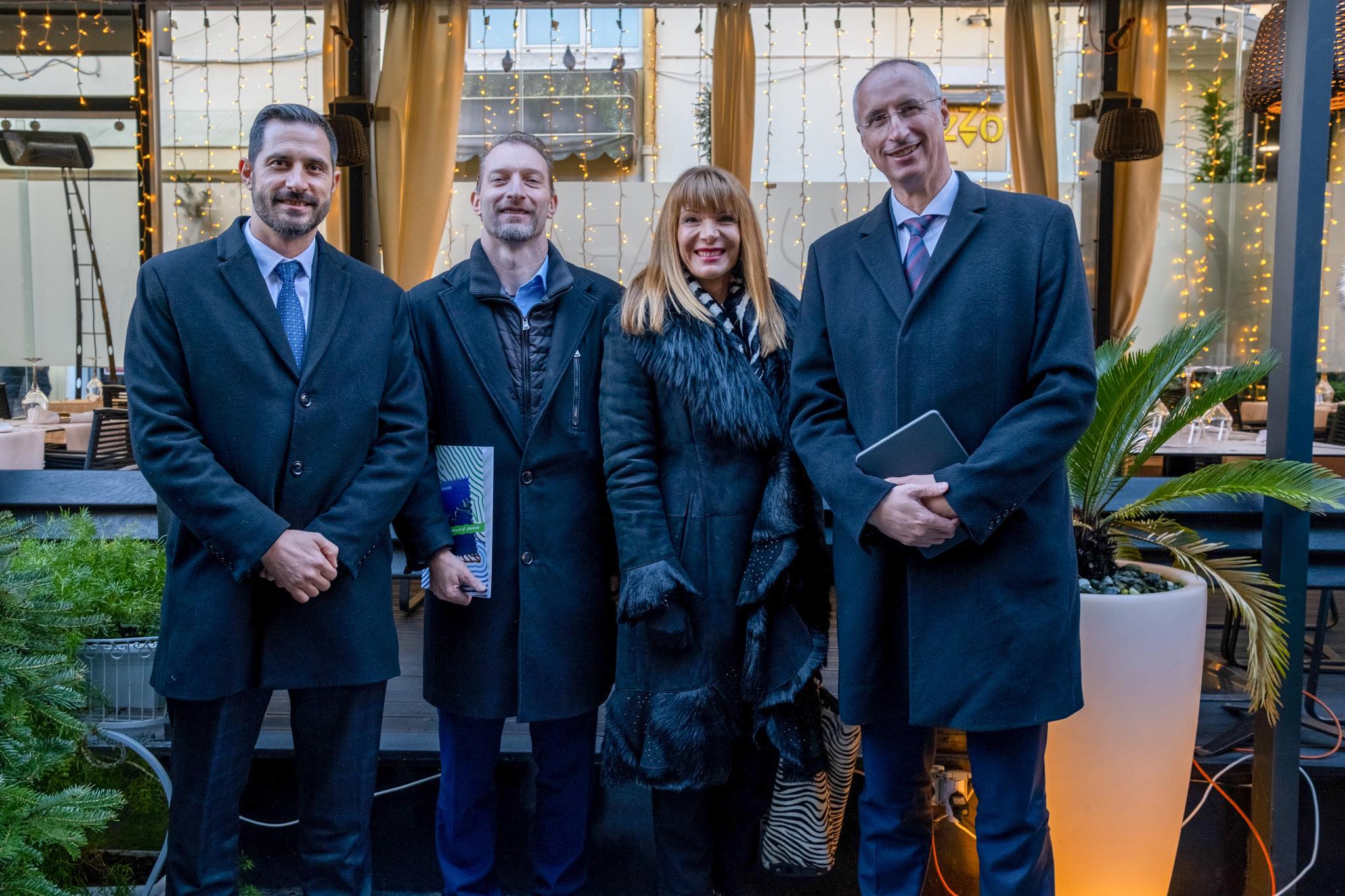
(TCN Split Winter Tourism Roundtable: State Secretary for Tourism, Tonci Glavina, Former Central Dalmatia Tourist Board Director Josko Stella, Split Tourist Board Director Alijana Vuksic, and Mayor of Split Ivica Puljak)
In the last ten years, Split has experienced a large increase in the number of tourists. From a transit city, it became a tourist destination. Today, a large number of citizens of Split live from tourism, which has become an important part of our economy and everyday life. Such a sudden increase in tourism brought with it many challenges, from overstretched infrastructure to problems with maintaining public order and peace. I think that Split is now entering a new phase, in which tourism should be seen as an opportunity for further development, connect it with the modern economy and use its full potential. Therefore, it is necessary to make a comprehensive tourism development strategy and harmonize it with the city development strategy. It is a very important process, which will define the future of the city in the long term.
This year, a special challenge is the fact that the structure of the guests is dominated by young people who want to have fun. Part of the tourist offer, which developed somewhat spontaneously, includes the widely and easily available consumption of alcohol, which produces frequent violations of public order and peace. Due to inherited rules and procedures, which do not foresee punishments for many forms of indecent behavior, the introduction of public order and peace is difficult. Therefore, we have prepared short-term and long-term measures to improve the situation in tourism.
Short-term measures include increased controls of the most frequented locations, along with synchronized actions of city, county and state authorities, police and inspectorates, as well as increased cleaning and beautification of the city.
Long-term measures are based on creating a tourism development strategy, changing the structure of guests, making a new decision on communal order, which will incorporate all the observed shortcomings and take over the best practices of cities that have encountered similar problems, then increasing the number and scope of operations of the order services, the inspectorate and the police, limiting and demotivating the sale and consumption of alcohol, up to incentive measures for the development of cultural, scientific, health, sports and congress tourism.
In the end, our view of tourism and its role in the development of the city is positive. Tourism can be an engine for the development of a modern economy, and as an instrument for the modernization of society and integration into world social and economic trends. On the other hand, in the development of the city, we will always put the interests of the citizens of Split first. When a city is good for its citizens, it will also be good for its guests.
Encouraging words. Let's hope they will soon be backed up with actions.
Rather than add my own thoughts to all this (which had been the original intention), I will stop here, as you don't need me to interpret the direct words of some of the major stakeholders.
But TCN will be exploring this topic in more detail, and we are reaching out to other key stakeholders for their points of view. I am very grateful to the founder of Ultra Europe, Joe Basic, for agreeing to an interview on this topic and the Ultra factor, as well as Zoran Pejovic, a renowned, Split-based luxury tourism consultant, whose many achievements include introducing the first wine bar, Paradox Wine and Cheese Bar, to Split a decade ago (when Split was a different city), as well as delivering the excellent 5-star Maslina Resort on Hvar.
If you have some expertise to contribute to the debate, please contact me on This email address is being protected from spambots. You need JavaScript enabled to view it. Subject Split Tourism.
Discussions like these are always painful, but often necessary. I am confident that with the right approach, we can fix a lot of these problems relatively quickly and get Split back to being the world-class destination that it fundamentally is.
ULTRA Europe Festival founder Joe Basic was kind enough to give me an interview on the subject, and he had some GREAT analysis and suggestions. ULTRA Europe Festival's Joe Basic Talks Split Tourism .
****
What is it like to live in Croatia? An expat for 20 years, you can follow my series, 20 Ways Croatia Changed Me in 20 Years, starting at the beginning - Business and Dalmatia.
Follow Paul Bradbury on LinkedIn.
20 Ways Croatia Changed Me in 20 Years: the Insider Guide to Surviving Croatia will be out by Christmas. If you would like to reserve a copy, email This email address is being protected from spambots. You need JavaScript enabled to view it. Subject 20 Years Book
Tourist in Croatia? How to Help Street Cats in Split When Traveling
July 28, 2022 - It's impossible to miss street cats when you're traveling around Croatia, but what should you do if you find one in need? A look at how to help street cats in Split.
Street cats have become a symbol of Croatian coastal cities. Often photographed in a 'fjaka' state of mind, cats rule many Split neighborhoods - but that's not necessarily a good thing.
Multiplied in the summer months after kitten season in the spring, it's become increasingly difficult to care for the street cats in Split. And without an animal shelter in the city, much of the work is left to volunteer associations that labor day and night establishing trap-neuter-release programs while their homes act as shelters for cats needing medical attention. Not to mention the thousands waiting to be adopted or fostered.
So, what can you do if you're in Split and notice a cat (or several) in need? Some tips from Split animal associations:
- Perhaps the easiest task as a tourist looking to help street cats in Split is to feed them and leave them water. Unfortunately, summer in Croatia is no walk in the park for humans, let alone street cats with no cool place to call home. However, it's simple enough to find a container for water and purchase wet or dry food at the local supermarket to leave in the cat-populated areas.
- If you find a cat or kitten that's obviously a stray but does not look sick, lost, or confused, it is best to leave it on the street rather than take it to your accommodation if you have no intent on giving it a permanent home. It is not easy to find fosters in Croatia, and while you might think you're doing the right thing by giving it a safe place for a few days or a week, it will likely end up on the street again after being pampered and acclimated to regular meals. This means it can become disoriented with less chance of survival when back on the street.
- If you find a sick and injured cat or kitten, it's best to take it to the nearest vet and see if they have the option of keeping it in a cage until it gets better. Most vets have this option for a fee. You can find the phone numbers for vets in Split below.

And perhaps the best thing you can do? If you're financially able to donate, support a local animal association. They rely on the donations of others to survive, with little to no help from the city, meaning trap-neuter-release programs, medications, fosters, food, and transport are taken care of thanks to your donations. They also have many cats and kittens available that desperately need a foster family if you someone you know is a candidate. Animal associations may also be able to help you catch a sick or injured street cat that needs to be taken to the vet, though the summer months are hectic with multiple calls a day, so keep this in mind if you don't hear back right away. Remember, they are volunteers, after all.
You can find a list of animal associations in the Dalmatia area in our Animal Associations and Shelters in Croatia series HERE.
For more, check out our lifestyle section.
Korcula to Split via Peljesac Bridge: A Heavenly, Speedy Road Trip
July 28, 2022 - While most of the Peljesac Bridge commentary has been focused on connecting Dubrovnik, access to the islands of Korcula and Mljet has just improved considerably. TCN road tests the new drive from Korcula to Split.
One of the very few things I don't like about Korcula is its accessibility. Driving down from Zagreb is already a fairly long day, without having to either plan your trip around two ferries (Ploce to Trpanj, Orebic to Korcula) or two borders (the Neum Corridor) and then driving the length of the Peljesac Peninsula.
That all changed yesterday.
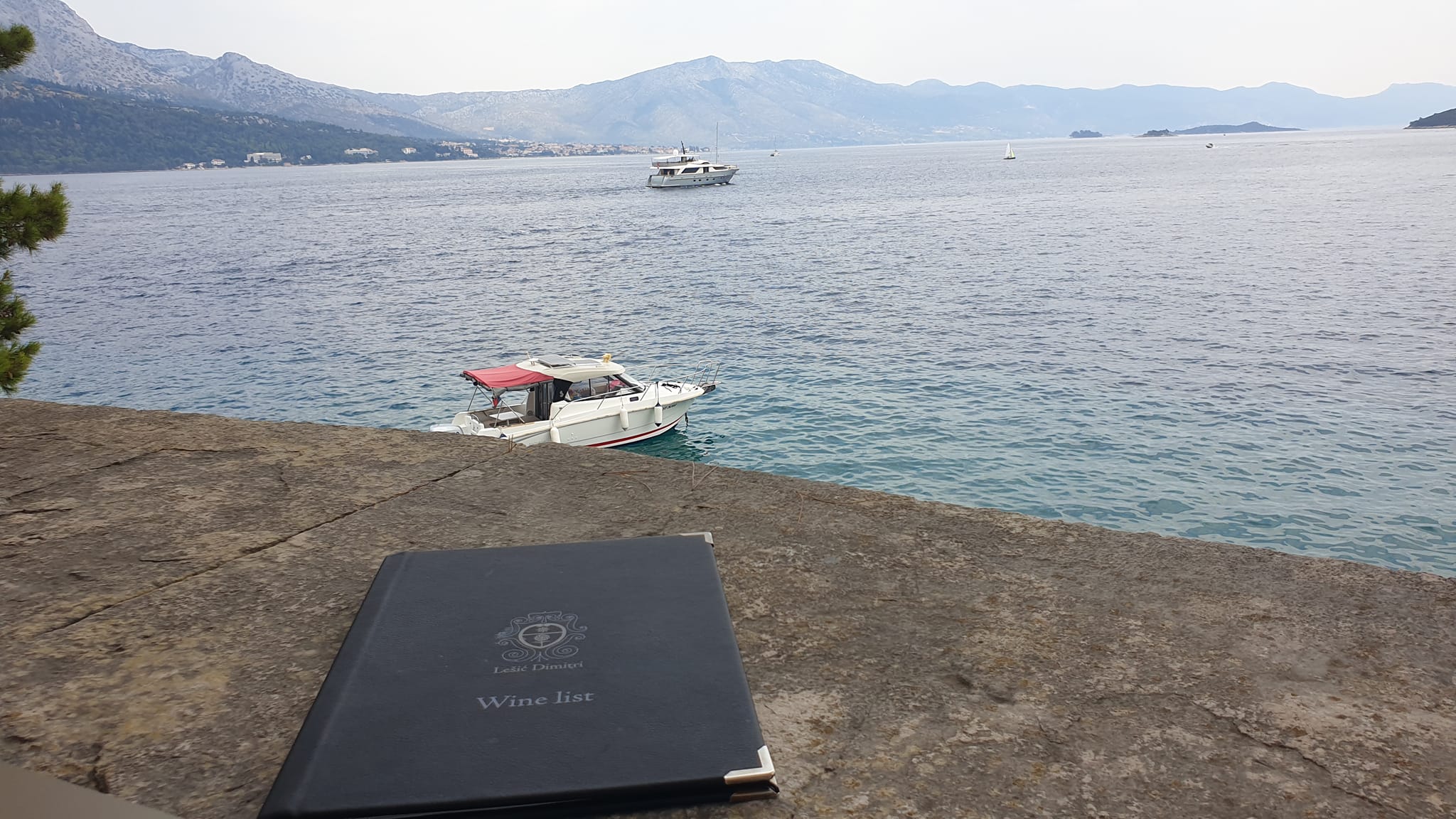
And sitting in my favourite place in Dalmatia, the Michelin Star terrace of Lesic Dimitri Palace, thoughts of the onward journey were not as terrible as usual. Leaving such a divine spot is always a wrench, but at least this time, I would have the pleasure of trying out the new bridge and seeing just how much time I would save on my way to Split (Korcula to Split would normally take over 4 hours by car and ferry, and a painful 4 hours too - and this was assuming no border queues and the ferry schedule worked for you), starting from my favourite terrace on Korcula?

Actually I was starting from Venice, the delightful suite at Lesic Dimitri Palace, which is comprised of 9 outstanding 5-star suites in the town of Marco Polo's birthplace, under the theme Where the Silk Road Begins. Check out the latest addition, Sumatra.
After bidding my reluctant farewells to the Lesic team, it was a 5-minute walk to the Brodica, the small passenger ferry that runs on the hour to Orebic, price 23 kuna. A wonderful service from the centre of Korcula Town, so no need to drive to the ferry at Domince. From landing in Orebic, a 7-minute walk to my favourite free parking in Orebic.
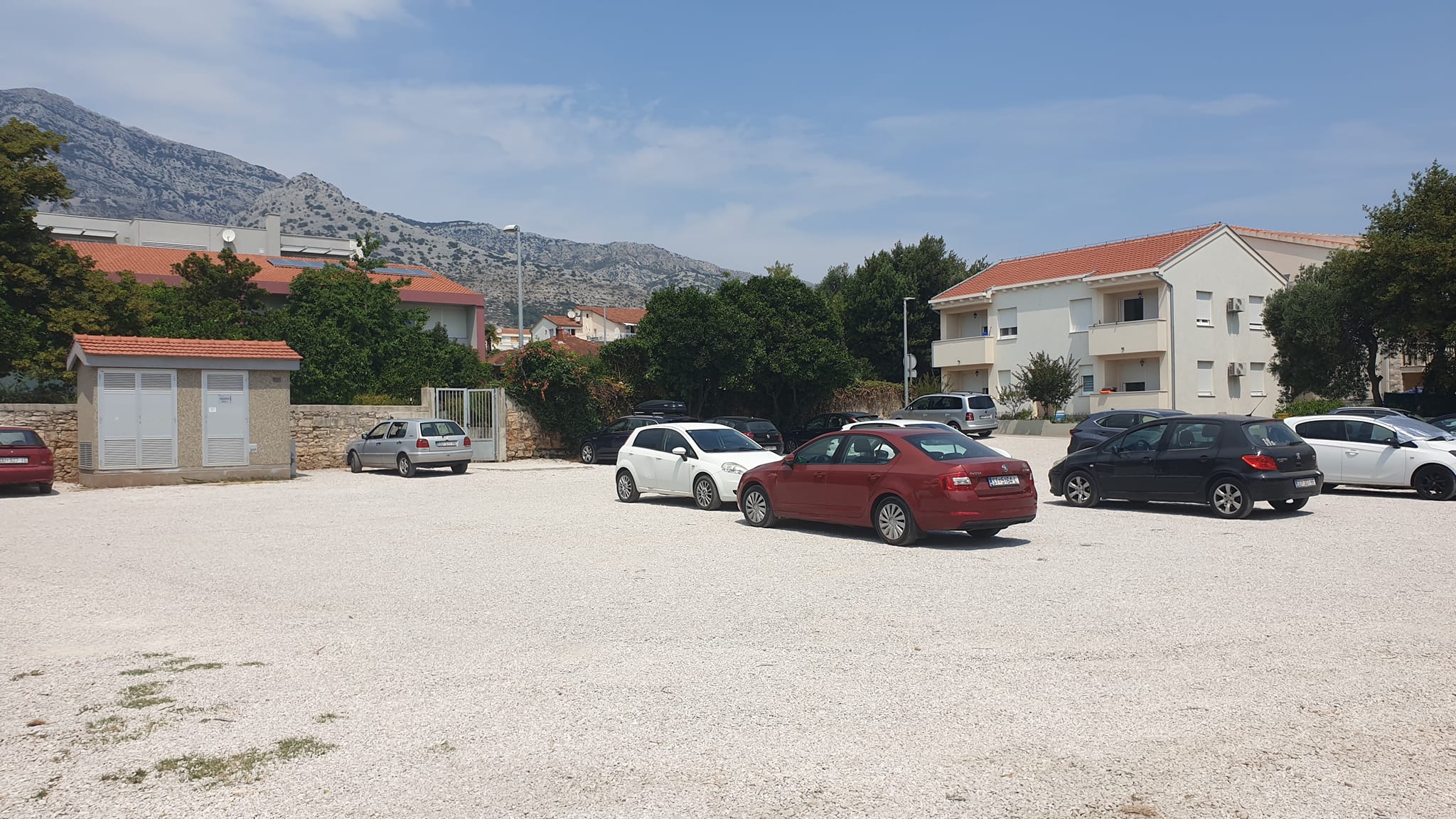
If I told you where it was, I would have to kill you. I don't want to publish details, but if you want to know, send me a private PM.
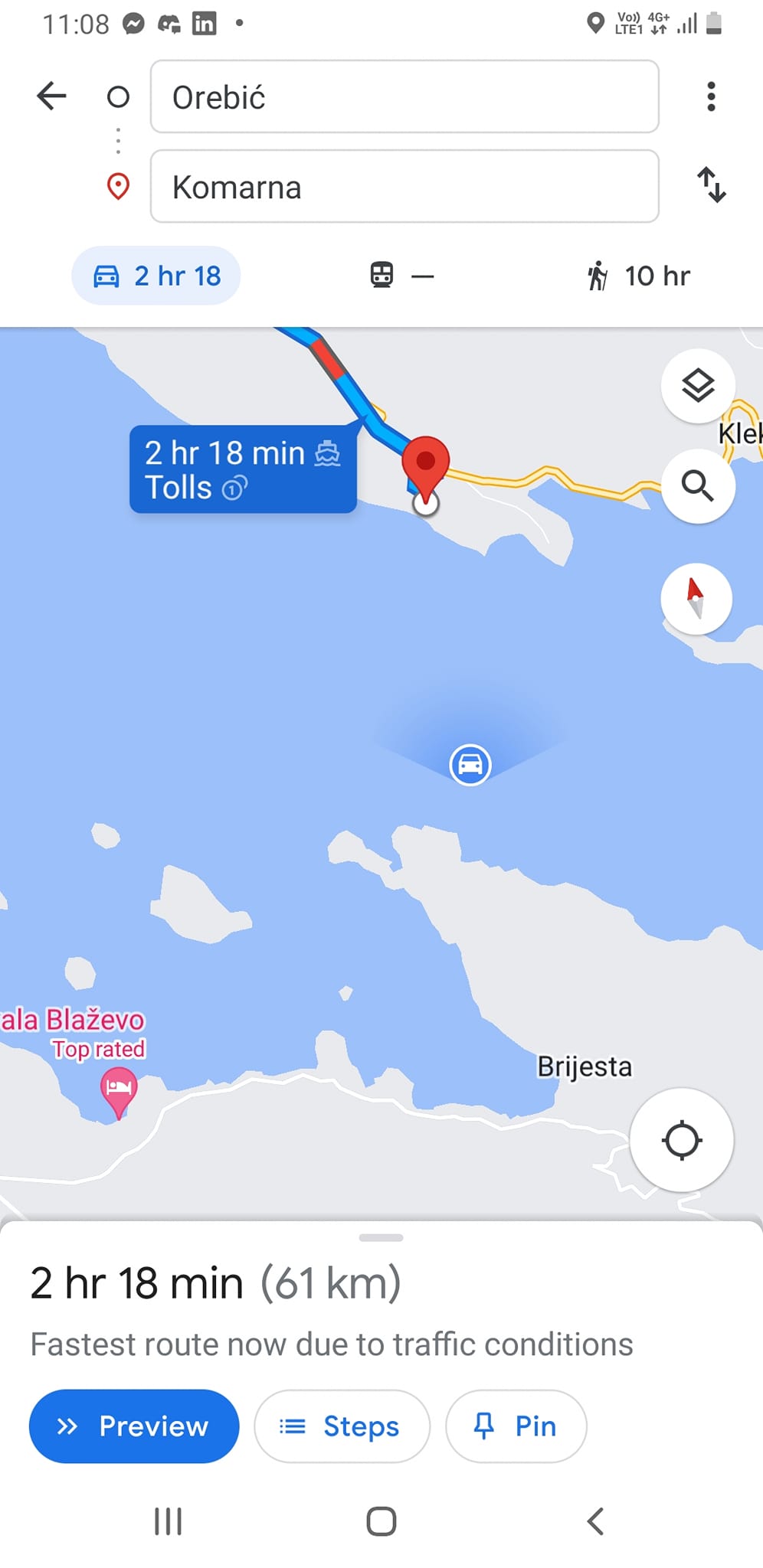
And then the drive. Although the bridge is not yet appearing in my Google Maps, it does for others. According to Google, I had a 45-minute drive to the start of the bridge at Brijesta. I finally learned to drive on water...
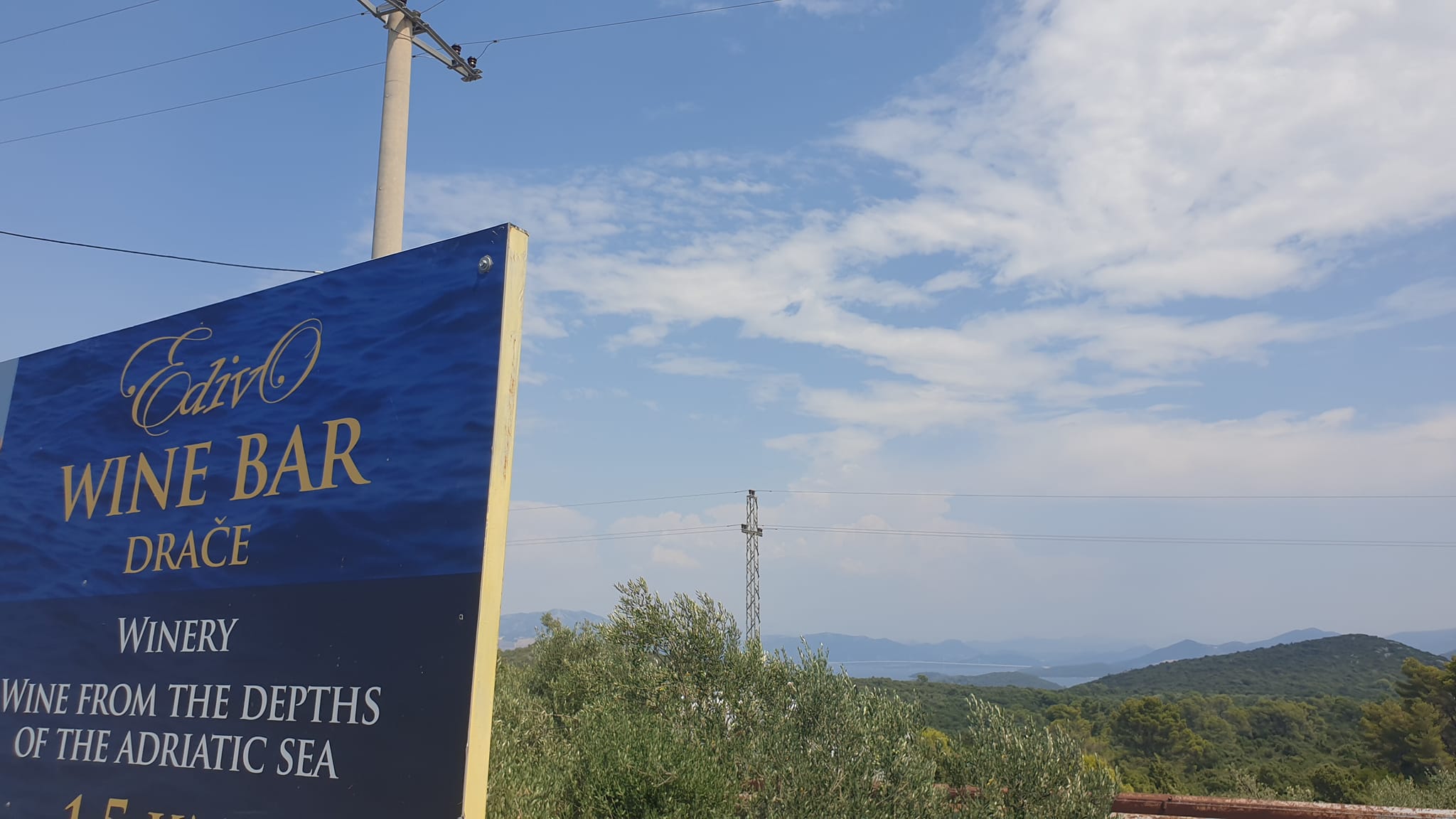
It was a stunning drive through hills offering ridiculous views of the Adriatic, combined with the temptations of some of Croatia's finest vineyards. For this is Plavac Mali country. There IS a bridge at the back of this photo, I promise. My legendary photo skills come to the fore again.
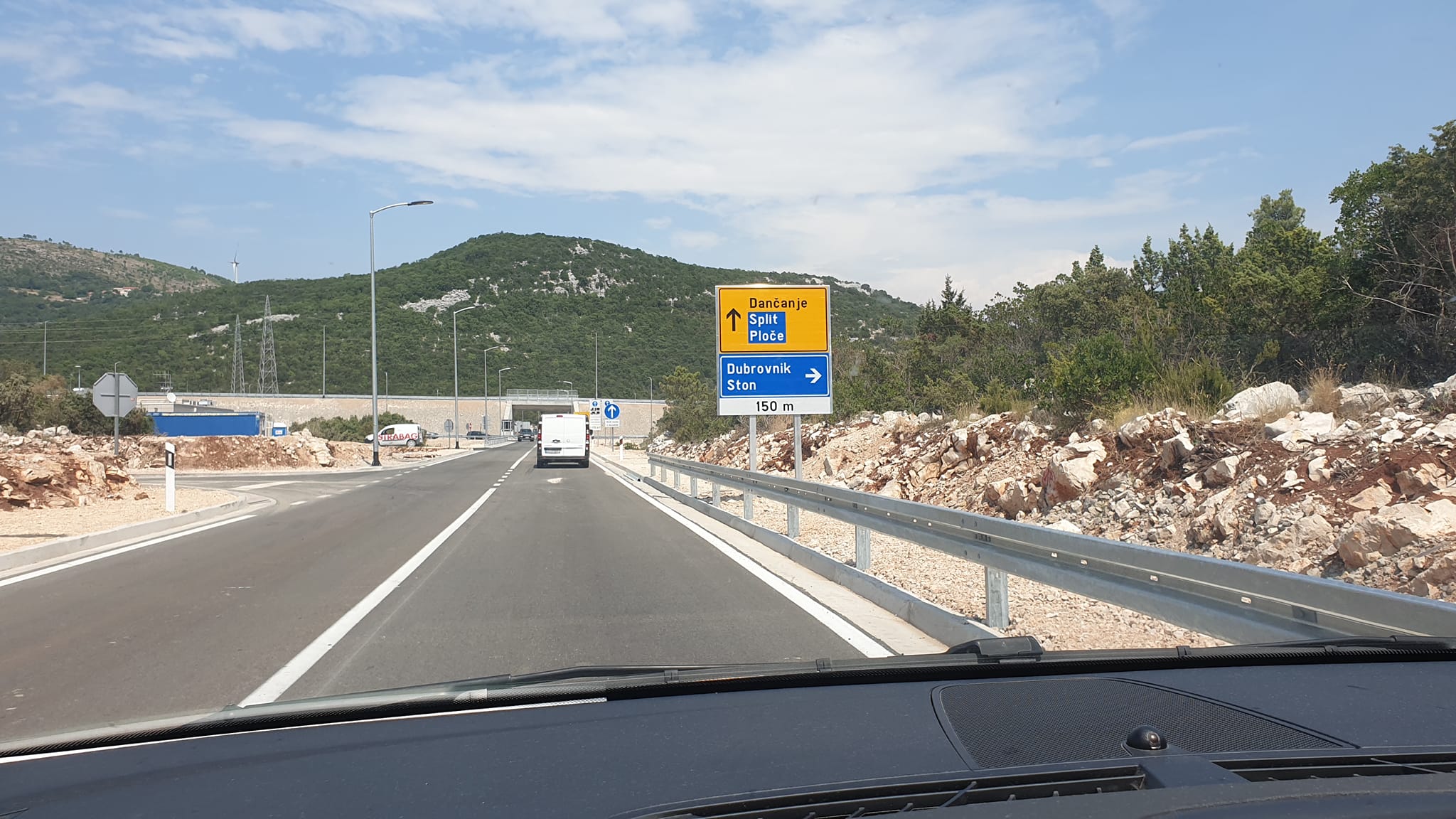
And, as we get closer to the bridge, new signage shows the new reality.
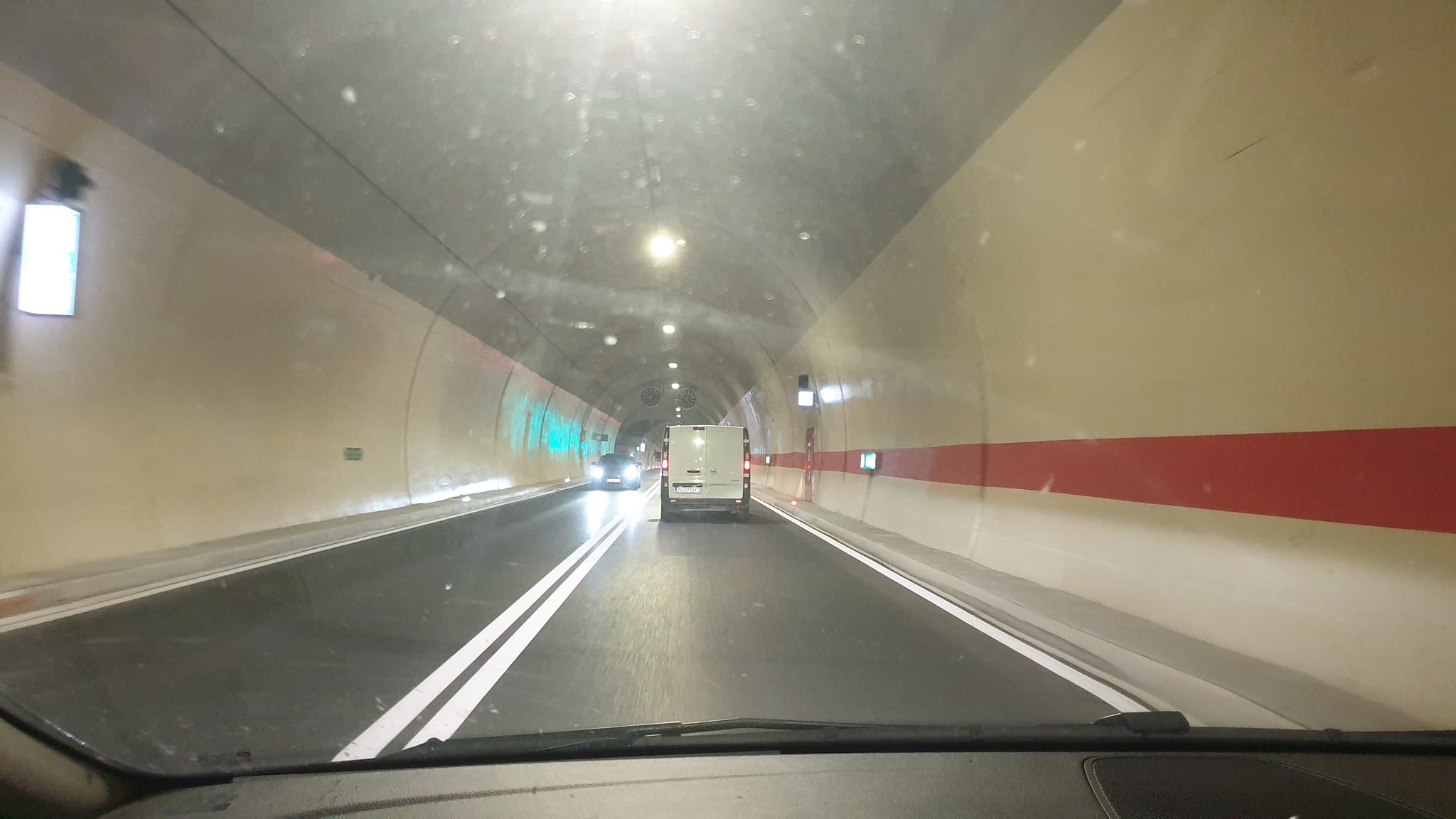
And a big surprise. a tunnel as long as the bridge itself - some 2.4 km) underneath (presumably) those gorgeous vines.
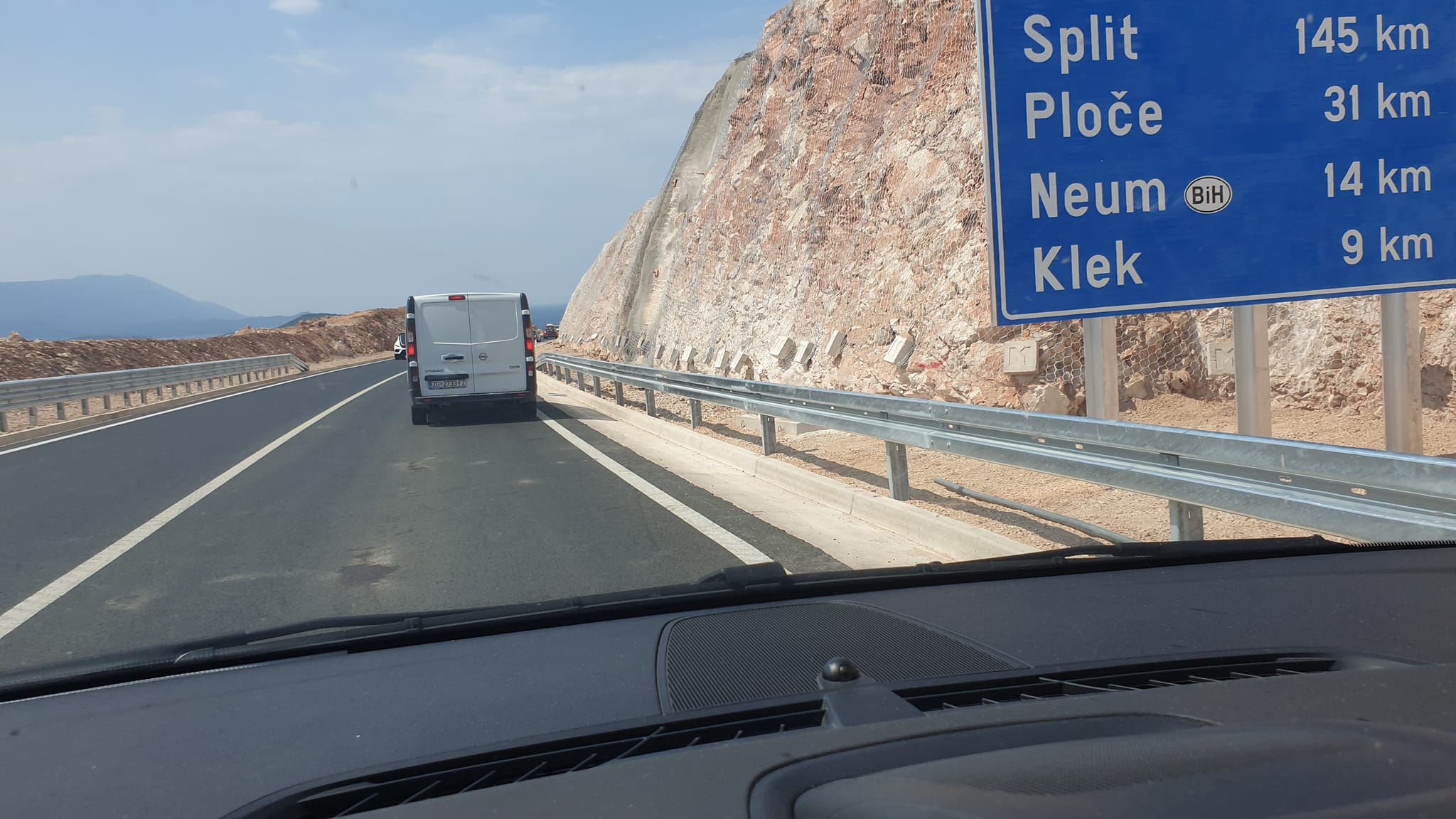
And as we edged closer to Croatia's new star connection, a smile. Just 145 kilometres to Split, and most of that motorway. Heaven.
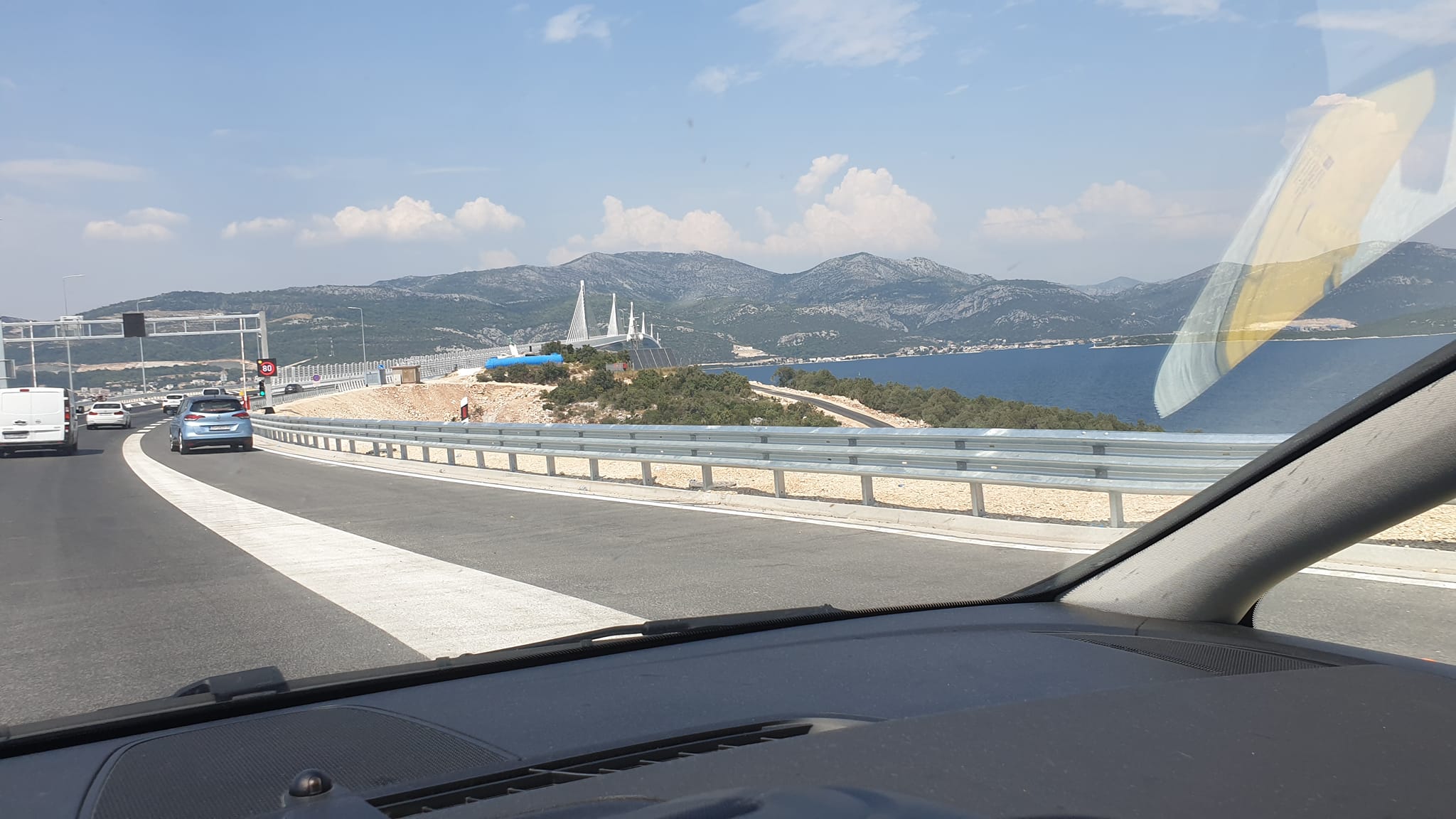
And then the bridge finally came into view. And what a beauty she is. I am more into Dalmatian benches than bridges, but I have to admit that this one is a beauty.
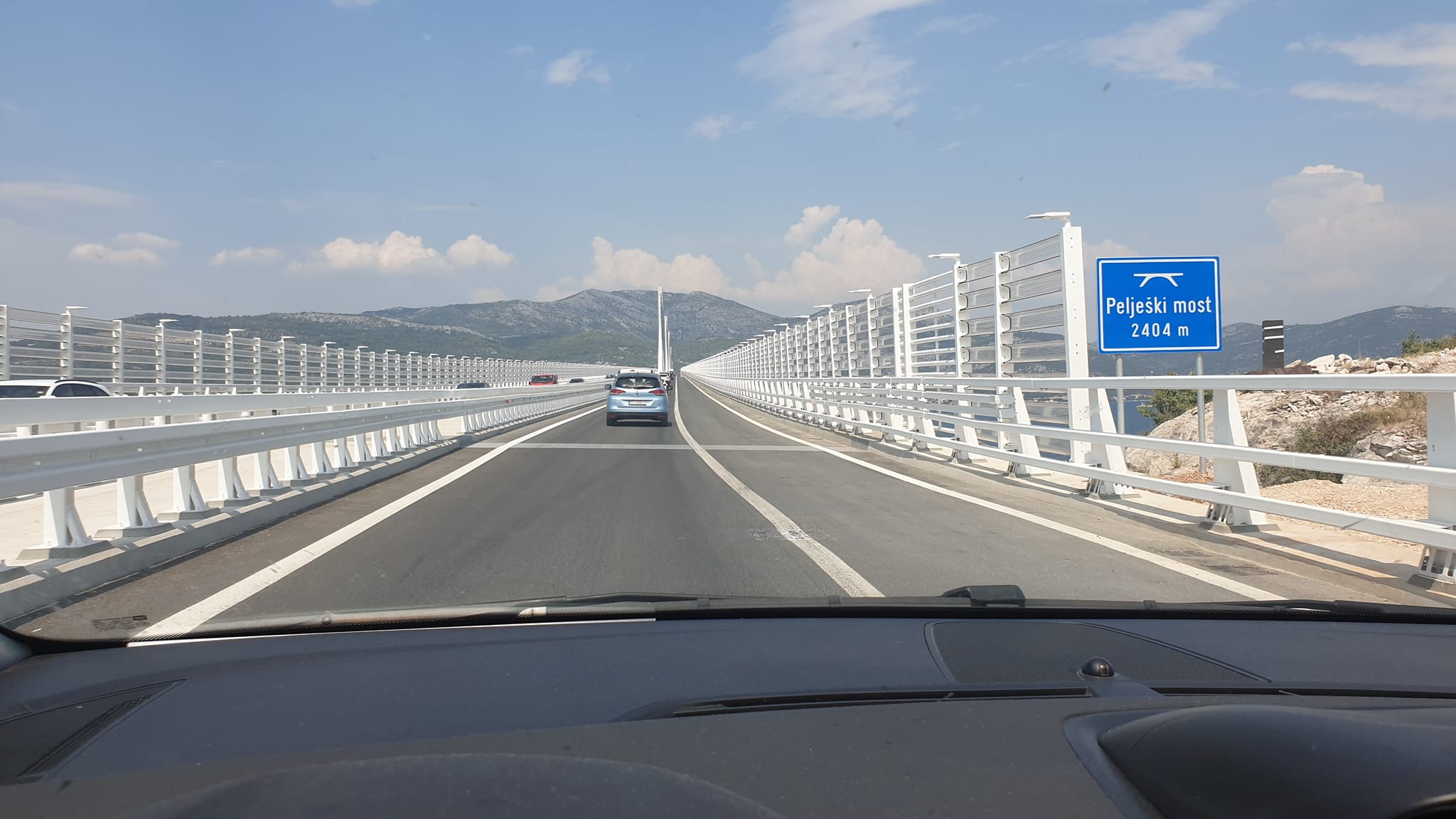
The 2,404 metres that will change the lives of many - for the better.
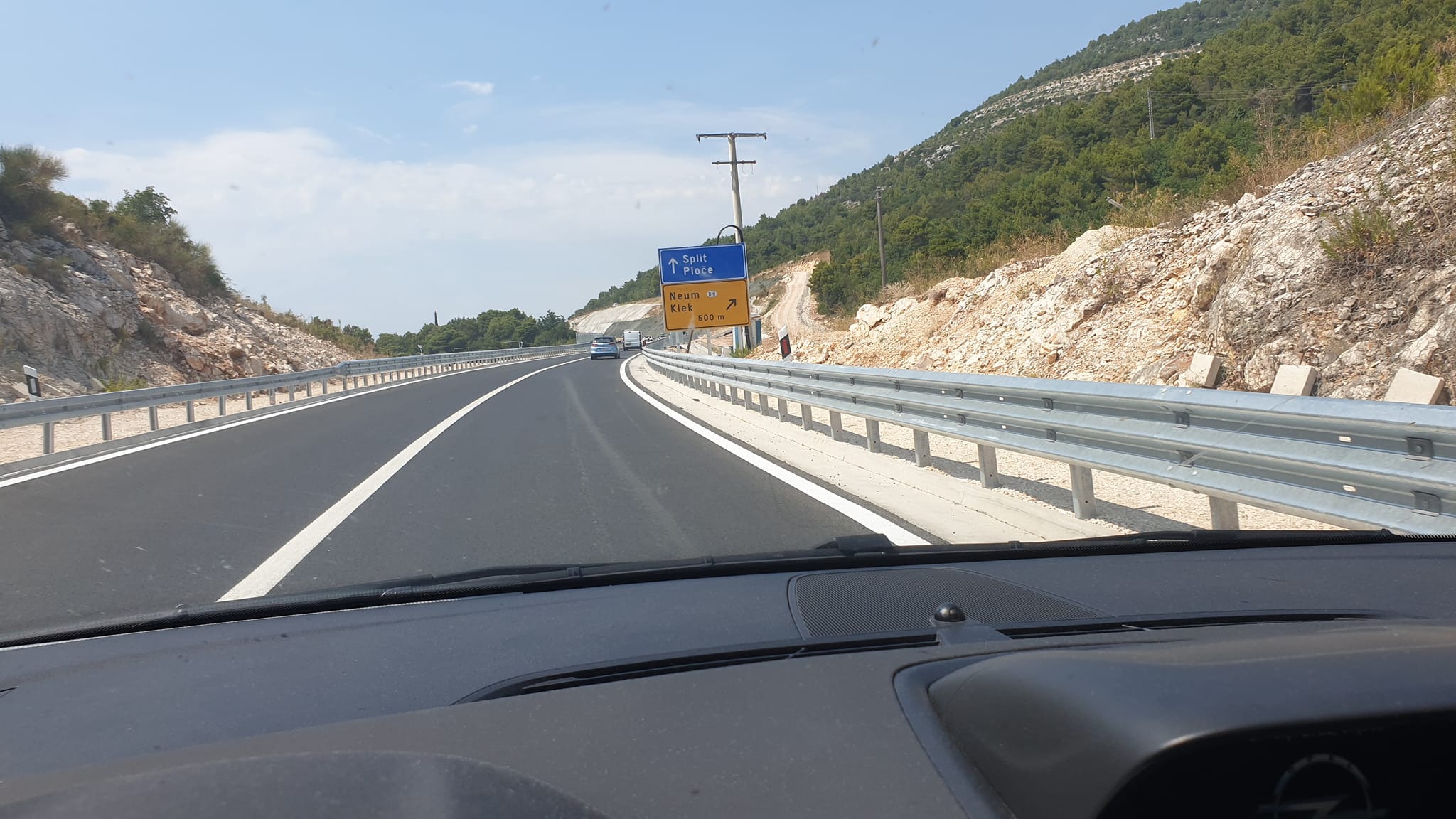
On the other side, new signs take you to Neum if you want to go, but the main direction is Split.
A short drive to Ploce and then joining up to the motorway to Split, toll price 50 kuna.
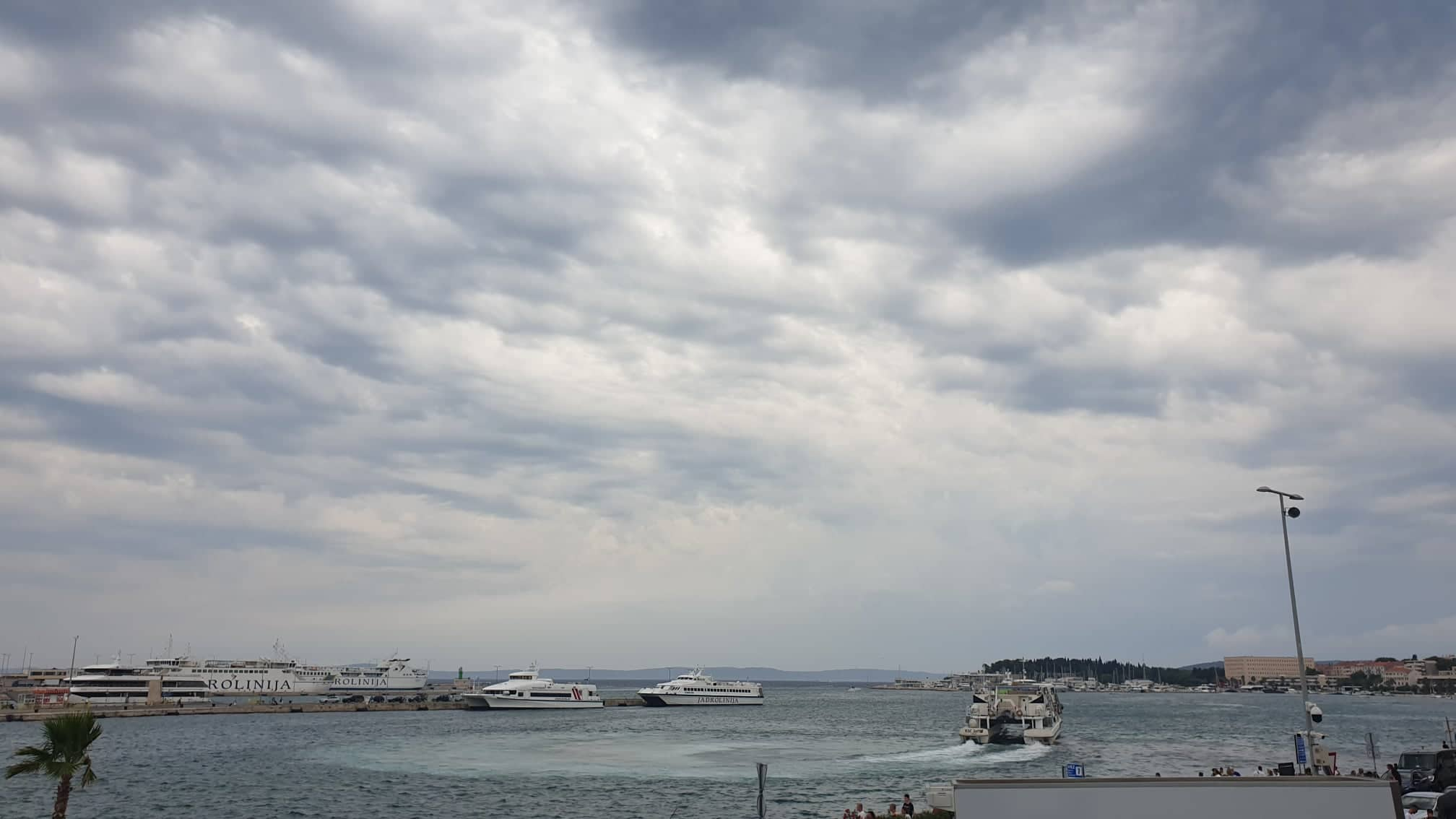
And after some time in what was honestly one of the most pleasant and stress-free peak season drives during my time in Croatia, the journey from Korcula to Split ended with a cold one on the riva, with clouds and a merciful gust of wind and threats of a storm.
Total travel time from Korcula to Split, including the boat - 2 hours 50 minutes.
My favourite place in Dalmatia just got a little closer.
So how was traffic on the bridge and also at the Neum Corridor on the first day of the new reality? Check out the TCN video report below.
****
What is it like to live in Croatia? An expat for 20 years, you can follow my series, 20 Ways Croatia Changed Me in 20 Years, starting at the beginning - Business and Dalmatia.
Tourist Boat Sinks in Split in a Freak Accident
July 24, 2022 - A very unusual maritime accident happened early Sunday morning in Split, when a tourist boat called Morska Vila hit the waterfront and sank.
Luckily, all of the passengers aboard the boat were able to leave the boat without injuries after it hit the waterfront at the gas station in Split. The 21-meter vessel came to Split from the direction of Čiovo
The Croatian media report today that the 44-year-old captain of the Morska Vila was apprehended right after the accident, as he was clearly under the influence of alcohol. The police have reported that he had over 0.1 per cent blood alcohol level, while the rest of the crew have tested negative for any alcohol. The Ministry of the Sea, Transport and Infrastructure reported that they're undertaking the necessary actions to secure the crash site and ensure that the sea's pollution around the vessel is minimal. The Split firefighters set up a barrier around the boat, and the divers were sent to investigate the bottom of the tourist boat to see the extent of the damage. The Ministry is also investigating the total number of people on the boat at the time of the accident. The media reports vary, as some say there were 41 people, while others mention over 50. There are reasons to believe that there were more people (passengers + the crew) on the vessel than is allowed, which is just another potential transgression by the captain.


